MyBoston
BACK BAY & BEACON HILL
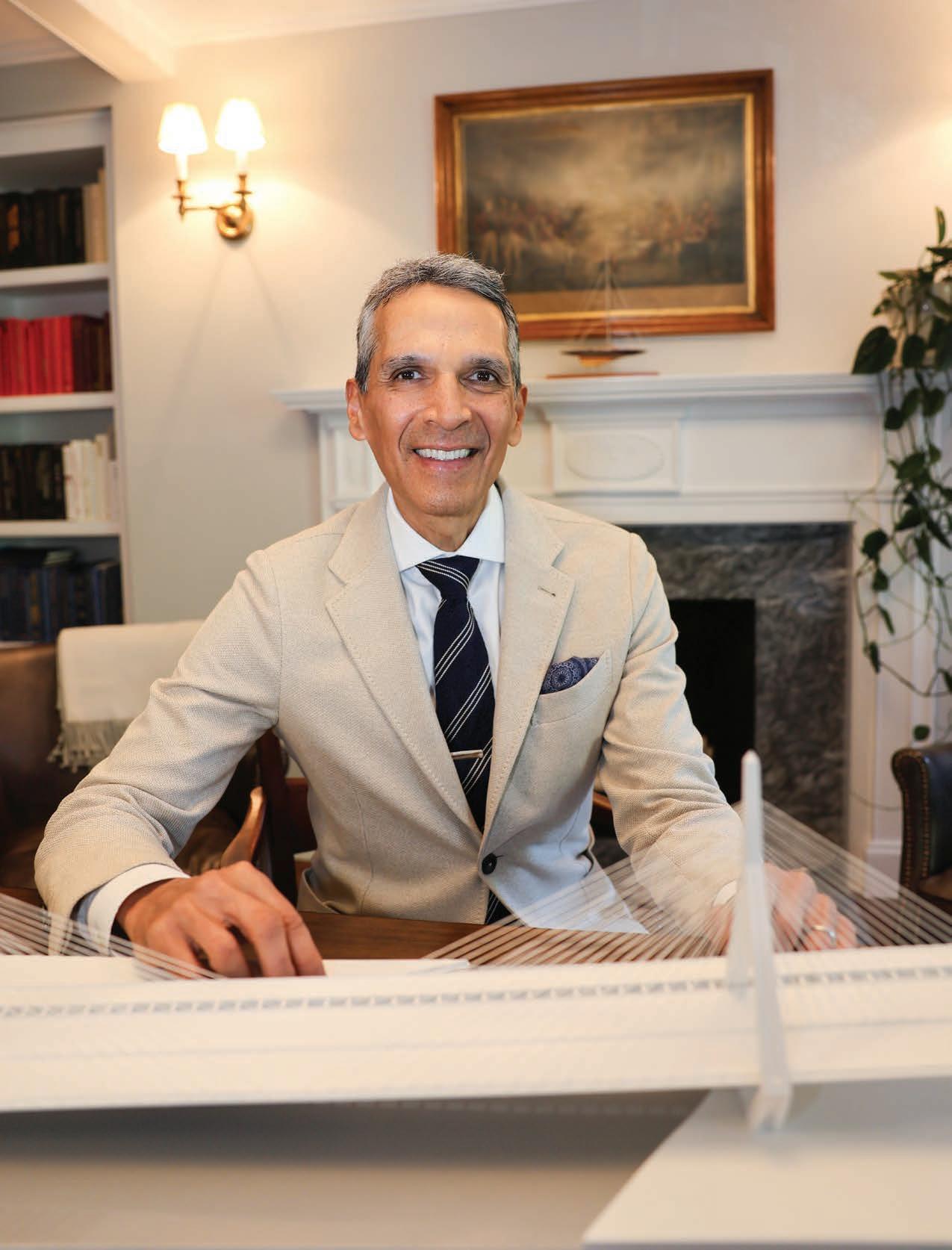
PERSONAL STYLE
5 BEST CONSIGNMENT SHOPS
DISTINCTIVE VISION
FASHION-FORWARD
EYEGLASS FRAMES
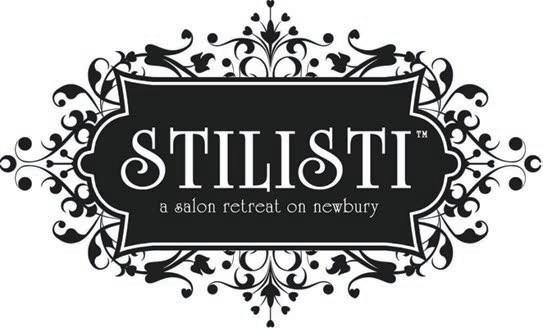
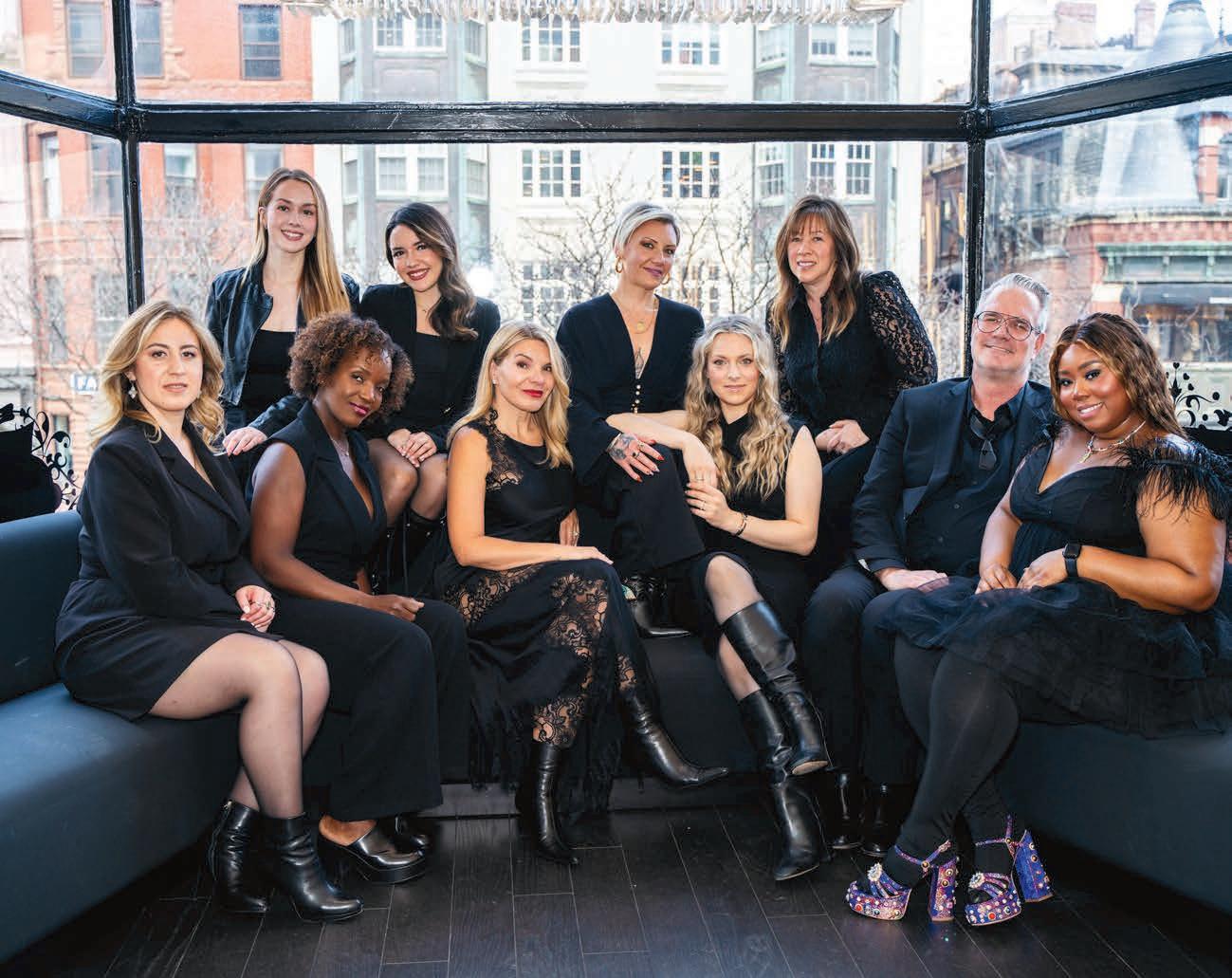


PERSONAL STYLE
5 BEST CONSIGNMENT SHOPS
DISTINCTIVE VISION
FASHION-FORWARD
EYEGLASS FRAMES



Founded by Marisa Marino—an industry veteran and mentor—Stilisti is more than a salon. It’s a space where artistry meets professionalism, and where stylists are trained to bring out the best in every client, strand by strand for 20 years.
We’re proud to give back to the community that inspires us, including hosting annual cut-a-thons to benefit Boston Children’s Hospital and supporting causes close to our hearts.
Whether you’re visiting for a transformative color, precision cut, or personalized styling, you’ll find yourself in expert hands.

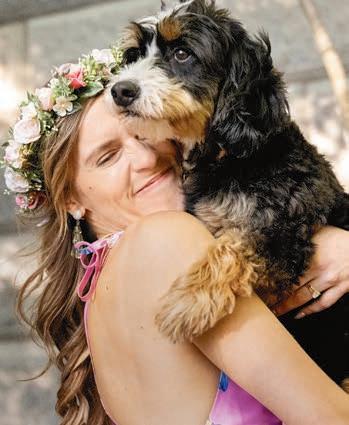


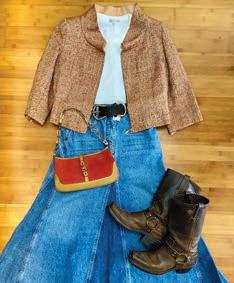


12 The Art of the Bridge Meet world-renowned architect and Beacon Hill resident Miguel Rosales, designer of the Zakim bridge.
17 Distinctive Vision
Newbury Street-based optometrist Blink offers a remarkably unique collection of eyeglass frames.
20 Canine Connections
How do dogs bring us together? Let me count the ways.
4 PUBLISHER’S NOTE The Rhythm of Fall
6 LOCAL PULSE Community Calendar
10 LOCAL TASTES Porto
26 5 BEST Consignment Shops for Clothing
30 NEIGHBORHOOD NOTES Supporting the Unhoused
32 ASK THE EXPERT Antiques: An Eye for Elegance
34 BOOK CLUB Reflections on 9/11
36 LOCAL SOCIAL Community Gatherings
38 MY SUNDAY Lydia Costello
40 PHOTO OP Shakespeare in the Park
COVER
Architect Miguel Rosales
Photograph by Claire Vail
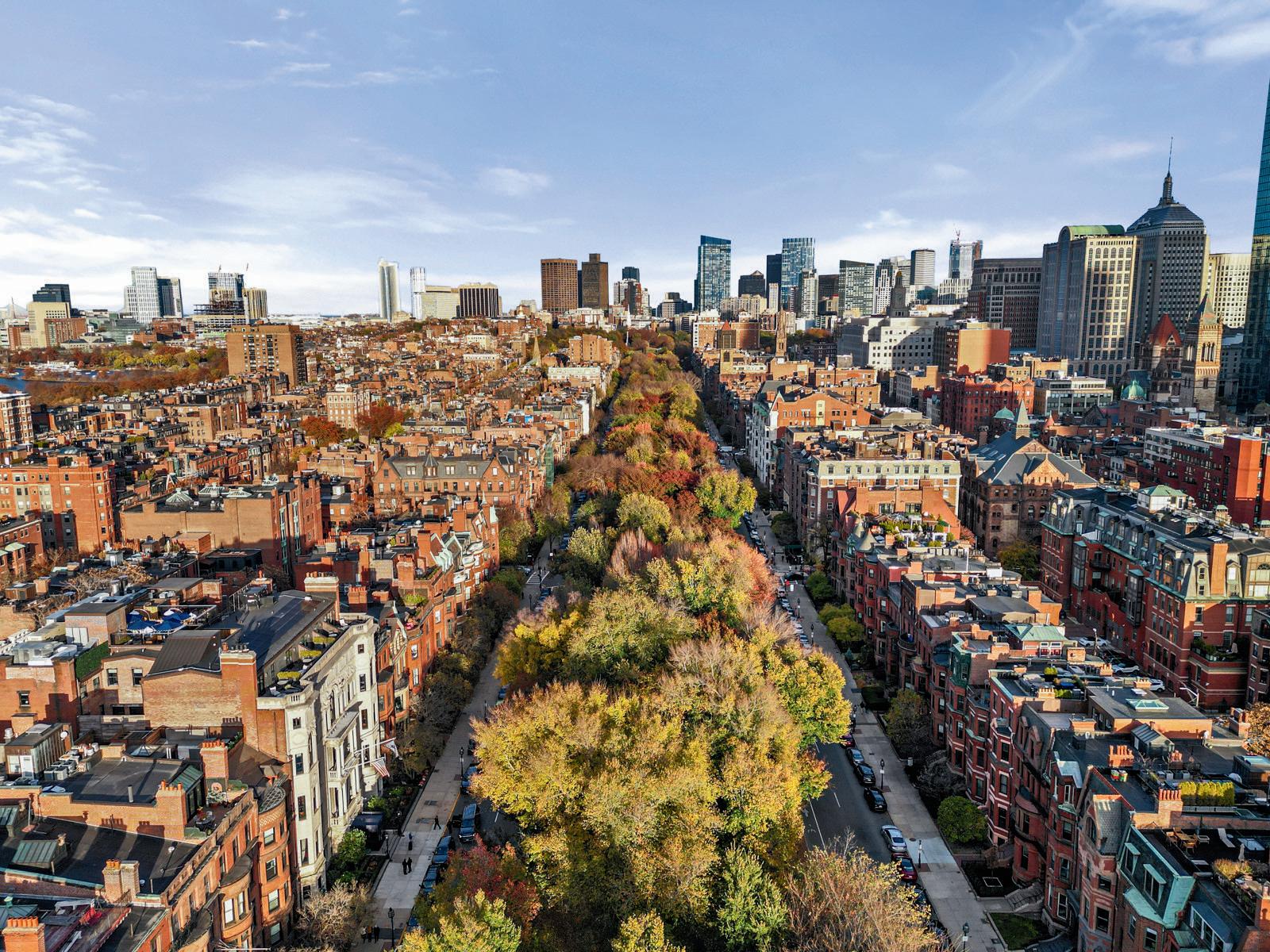


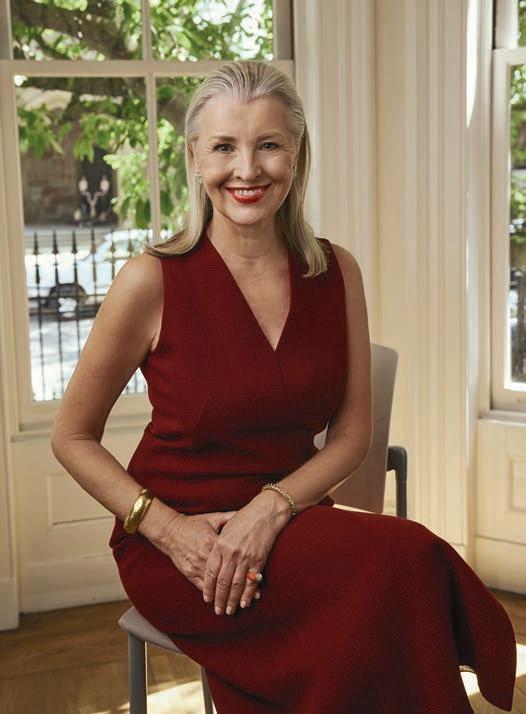
THERE’S SOMETHING about fall in Boston that feels almost architectural—light and shadow sharpen, the air turns deliberate, and the city returns to itself with a kind of poetic precision. Streets hum again. Cafés fill with locals again. The neighborhood exhales summer
and inhales structure, purpose, and pace.
In this spirit of return and rhythm, we are proud to feature world-renowned architect Miguel Rosales, the visionary behind the iconic Zakim bridge— and a neighbor quietly shaping skylines around the world from right here in our community. This issue also highlights a refined local eyewear boutique, reminding us that thoughtful design exists at every scale—from bridges that cross rivers and roadways to eyeglass frames that cross only the bridges of noses.
To our advertisers: Thank you for making this complimentary publication possible! Readers, when you stop by their businesses, tell them MyBoston sent you. And, as always, thank you for your thoughtful feedback. Hyperlocal is a community effort, and we welcome your stories, tips, and favorite finds—this magazine is yours as much as ours. See you in the neighborhood,

Renata Coker Publisher, MyBoston
www.mybostonmag.com @mybostonmag
Publisher
Renata Coker
Renata.Coker@mybostonmag.com
Editor and Photographer
Claire Vail editor@mybostonmag.com
Writers
Sarah McManus
Lisa Mulman
Paul Scheufele
Morgan Vail
Photographer Ben Flythe
Advisory Board
Collin Bray
Robert Dimmick
Leigh Harrington
Lisa Mulman
Sharin Schober
David Sharff
Cindy Sullivan
WAINSCOT MEDIA
Chairman
Carroll V. Dowden
President and CEO
Mark Dowden
SVP, Group Publisher
Thomas Flannery
VP, Content Strategy
Maria Regan
VP, Director of Digital Media
Nigel Edelshain
Creative Director
Kijoo Kim
Associate Editor
Sophia Carlisle
Advertising Services Director
Jacquelynn Fischer
Operations Director
Catherine Rosario
Production Designer
Chris Ferrante
Print Production Manager
Fern Meshulam
Circulation Manager
Kathy Wenzler
Advertising Production Associate
Griff Dowden
MyBoston magazine is published by Wainscot Media. Serving residents of Boston, the magazine is distributed monthly via U.S. mail. Articles and advertisements contained herein do not necessarily reflect the opinions of the publishers. Copyright 2025 by Wainscot Media LLC. No portion of this magazine may be reproduced in any form without written consent.
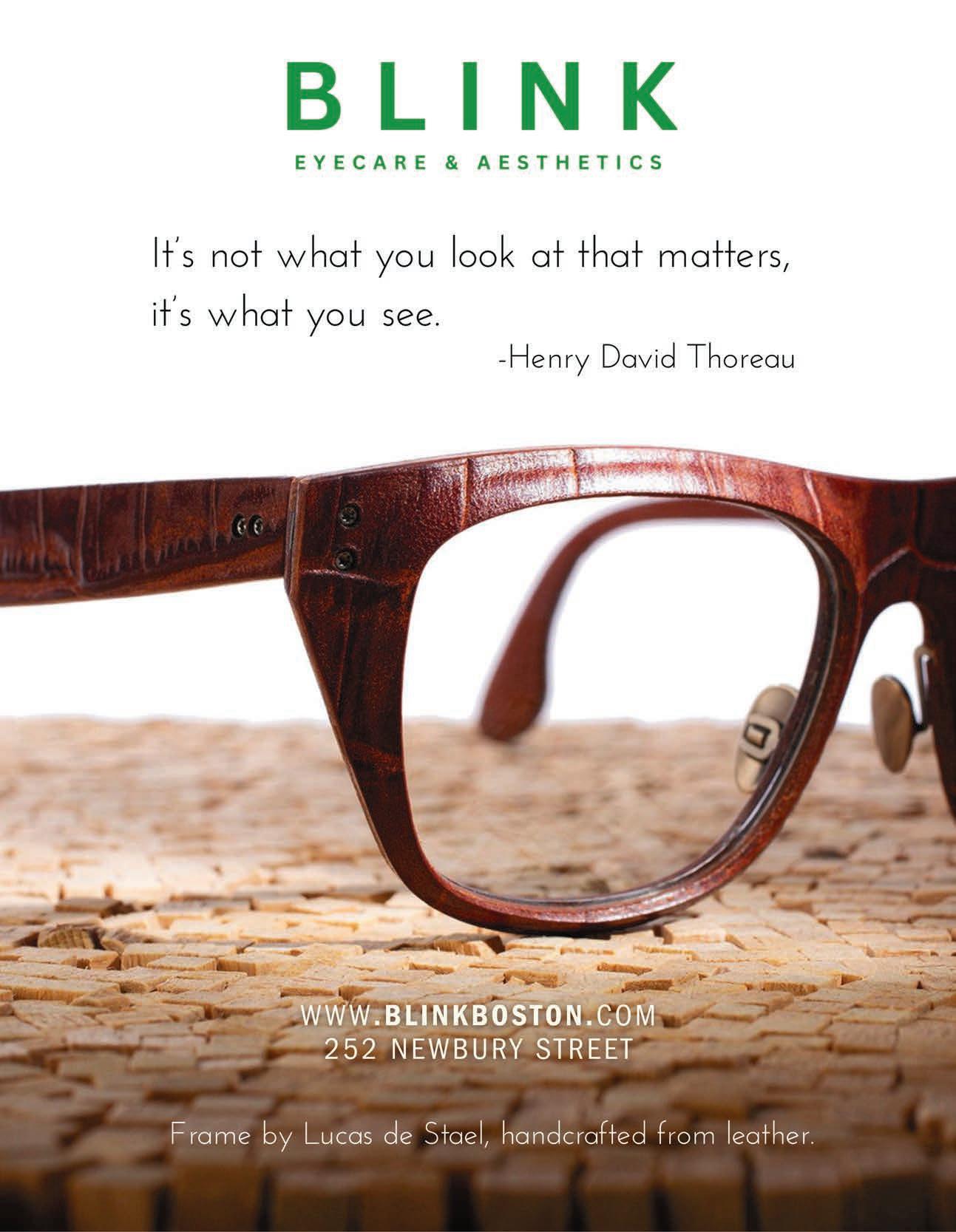
September spells stunning colors, cooler weather, crowds of college students and a bustling pace. Don a sweater, grab a latte and drop by this month’s art exhibitions, author talks, concerts, and happenings in Back Bay and Beacon Hill.
BY MORGAN VAIL
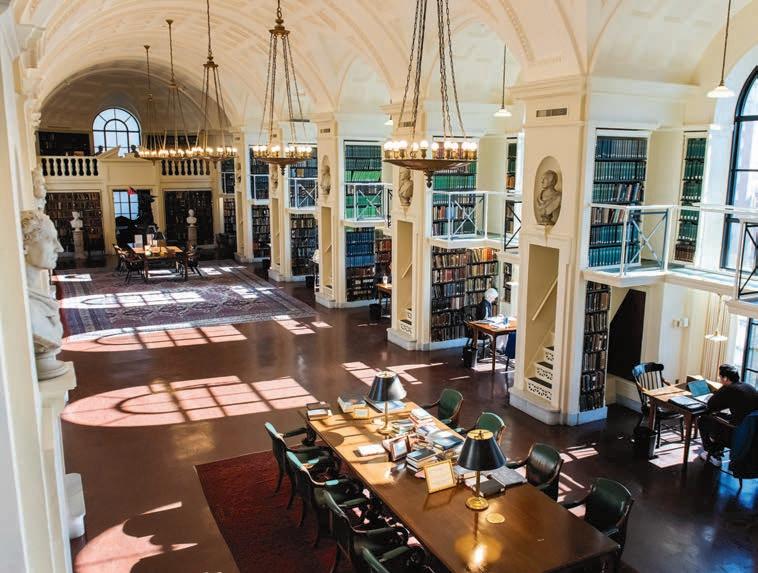
September 6
Athenaeum Community Day
The Athenaeum’s gorgeous space is open to the public for one day only. Explore twelve stories of stunning architecture and member-exclusive spaces at this unique library and iconic Boston institution. Drop in any time 10 a.m. to 3 p.m. at 10½ Beacon St. Free. 617-227-0270.
September 10
Michael Ansara:
“The Hard Work of Hope”
Attend a talk with author Michael Ansara, who will discuss his book “The Hard Work of Hope.” Learn about the civil rights protests of the 1960s and 1970s and the cultural backlash to the Vietnam War. Read the chronicles of young people who were on the front lines and discuss activism with the founder of Mass Poetry. 6 to 7 p.m. Free. 700 Boylston St. 617-536-5400.
September 11
Diplomacy Now
The U.S., China, and the Great Powers
Come to the Boston Public Library to hear a unique perspective on both democracy and diplomacy from a U.S. ambassador who served for over three decades under six different presidents, mostly handling relations with China. 6 to 7 p.m. Free. 700 Boylston St. 617-536-5400.
12 and 13
Art on Film
Expand your understanding of art with this series of German films, co-presented with the Boston Public Art Triennial. On September 12, 6 to 9 p.m. On September 13, 2 to 8 p.m. Free. Goethe-Institut Boston, 170 Beacon St. For more information, email Karin.Oehlenschlaeger@goethe.de.
BE+ Bike Tour
Join the BE+ Emerging Professionals for an urban bike tour that stresses sustainable design and construction. Along the route, guides will present fun facts and information about their work creating environmentally conscious buildings. Attendees must have a helmet, a bike, a ticket, and a completed safety form. The last two are available on Built Environment’s website. 10 a.m. to 2 p.m., Lederman Park. 617-752-2422. Rain date: September 14.
Boston Local Food Festival
Partake in the finest selection of Boston’s food makers, including (but not limited to) chefs, fisherfolk, producers, and farmers! Highlights include the Seafood Throwdown (a seafood dish race between two chefs in front of judges) and Chef Demos (showcases of vendors with free tastings). 11 a.m. to 5 p.m. Free. Atlantic Avenue. Rain date: September 21.
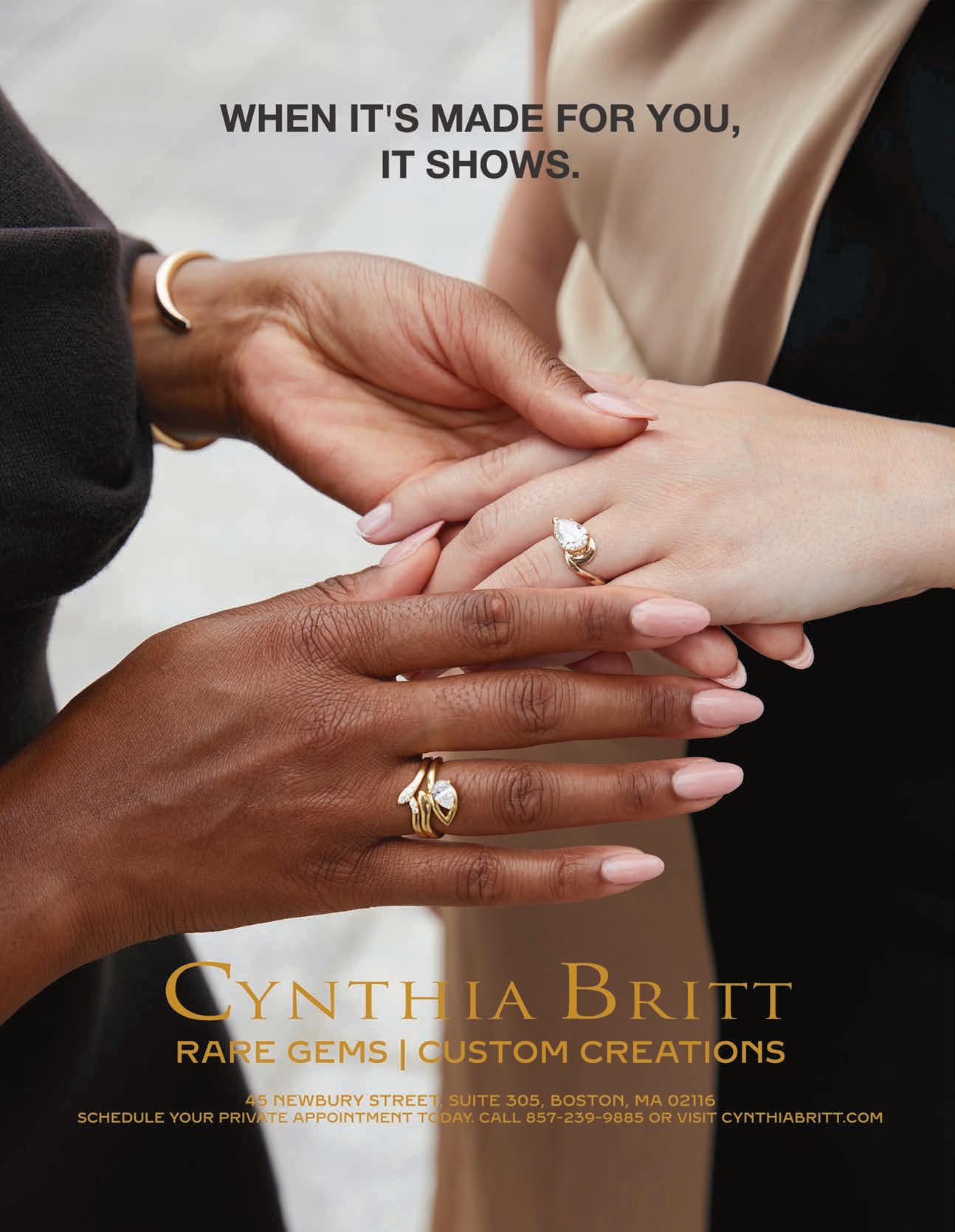
September 17
Bordeaux Wine Seminar
Part of the French Library’s Gastronomy and Wine Program, this seminar on the complex and storied wines of Bordeaux is suitable for anyone, from beginners to experts. Get a deeper understanding of French wines, refine your tasting skills and vocabulary, and gain confidence in making selections and food pairings. Also, taste an array of authentic, high quality French wines. 6 to 8 p.m. French Library, 53 Marlborough St. Call 617-912-0400 for tickets.
September 17
Reimagining Cole Porter: An Americana Roots Concert
Through the rich cultural medium of Americana, Cole Porter’s songbook is redone in arrangements for fiddle, mandolin, upright bass, accordion, piano, and more instruments by Grammy-nominated, award-winning producer Jamie Barnett. 7:30 p.m. Free. David Friend Recital Hall, 921 Boylston St.
September 23
“Alchemised” Release Party
Celebrate the launch of SenLin Yu’s new book “Alchemised” at Trident Booksellers & Cafe. Enjoy games, prizes, and chats in the company of other readers. 7 to 9 p.m. Tickets are available on Trident’s website for $43, which includes a copy of the book. Trident Booksellers & Cafe, 338 Newbury St. 617-267-8688.
September 27
Breakthrough T1D Walk
The largest global event created to fight Type 1 diabetes is this structured 5K walk for awareness. Register on Breakthrough T1D’s website or just show up to show support for participants. 9 a.m. Free. 47 David G Mugar Way. Contact 800-533-CURE for more information.
27
Getting Started in Family History
Learn how to make serious headway in your family history research with the experts at American Ancestors. Perfect for all levels of researchers, even those who are brand new to genealogy. From 1 to 2 p.m. on the second floor of American Ancestors at 97 Newbury St. $15 for non-members. Call 888-296-3447 for information about tickets or visit www.americanancestors.org.
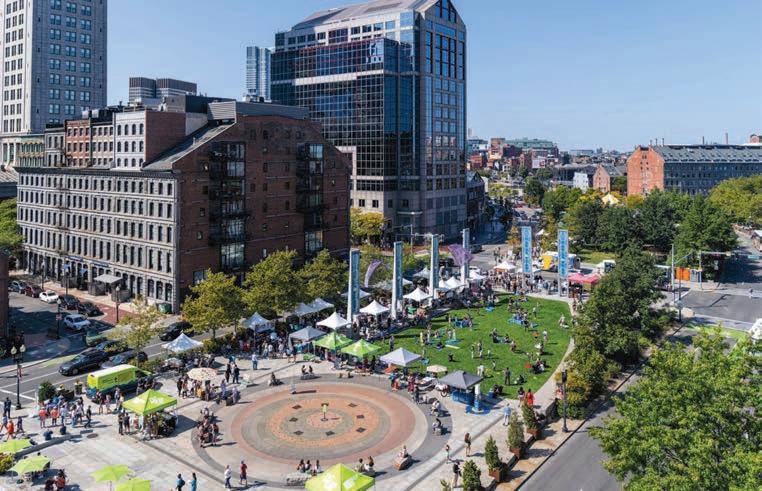
September 28
Come to Beacon Hill for a day of live music, food, beer, activities, a book sale, dog parade and much more. This event, sponsored by the Beacon Hill Civic Association, introduces residents and visitors to this iconic neighborhood’s nonprofits in a festive spirit. From 12 to 4 p.m. on the flat of Mount Vernon Street. 617-227-1922.
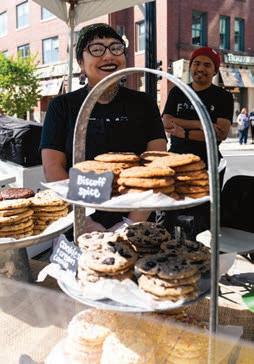

Right:
September 29
Music from the Mediterranean
A series of musical traditions sourced from the Mediterranean with Southern Italian chants, Romani laments, Greek and Turkish folk music, and Sephardic love songs. Do not miss this performance spotlighting the incredible voice of award-winning Carmen Marsico. 7:30 p.m. Free. David Friend Recital Hall at 921 Boylston St.
September 30
Aspire to write about your travels (or anything at all) in French? Discover ways to bring your words to life in this four-session creative writing workshop, led en francais by storyteller Félicie Petit-Nivard. From 6 to 8 p.m. Call 617-912-0400 for information.
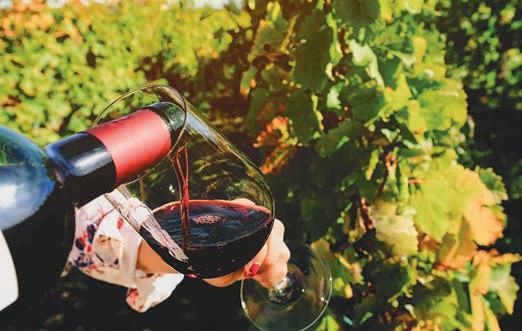

ANNA PETROPOULOS, MD, FRCS


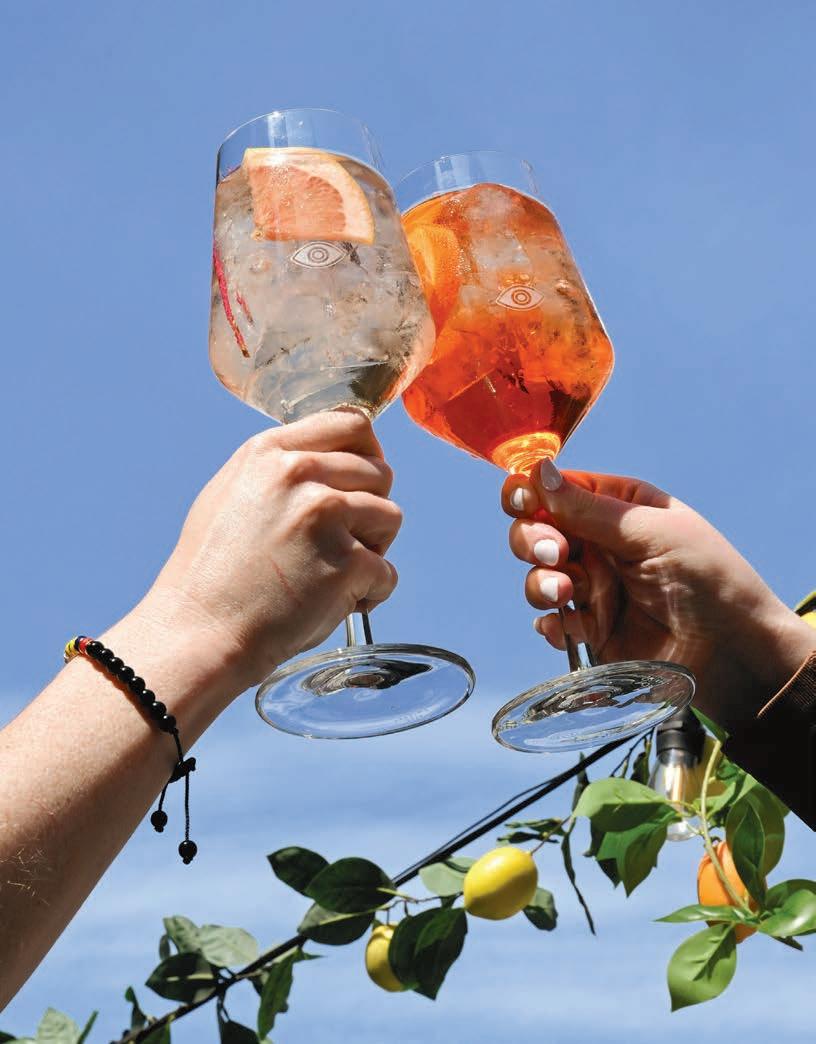
Porto’s chef, Josue Louis, serves up innovative coastal Mediterranean cuisine in the heart of Back Bay.
BY CLAIRE VAIL
PORTO’S WEBSITE promises that its food will transport diners “in riva al mari,” in this case, somewhere along the Mediterranean coast. In fact, executive chef Josue Louis’s menu extends far beyond the Italian riviera to Sicily, Spain, and Portugal, with exquisite stopovers in Turkey, Greece, and North Africa. It’s a trip worth taking.
Porto’s décor attempts to conjure Amalfi Coast ambience in the heart of
Back Bay, a challenge with Saks Fifth Avenue and the Pru looming overhead, and shoppers at Star Market milling below. The broad patio and bar are festooned with hanging garlands of lemons and sparking fairy lights, and servers deliver big balloon glasses of sunset-colored Aperol to a crowd of that lingers late to soak it all up. It’s cheerful and festive, especially once the sun begins to set, but Louis’s approach to Europe’s southern coastal
cuisine is the real star, producing dishes rich in flavor, in subtle and often surprising ways.
Louis excels at creating counterpoints of texture and temperature. An appetizer of tuna tartare is brightened by pear, ginger, and bright cilantro, but it’s the dash of earthy urfa biber—a Turkish chili pepper—that gives the tuna its smoky depth. A standard pairing of melon and prosciutto is transformed by a sidecar of cool melon gazpacho, an ingenious pour-over that perks up notes of sumac and mint, while the naturally nutty flavor of the ham is amplified by crunchy candied hazelnuts. Sizzling fried squash blossoms are tempered by chilled lemon ricotta, infused with chili honey and anchovy. Italian meatballs, traditionally prepared, are straightforwardly delicious.
Seafood, meat and pasta dishes are all consistently excellent. Pastas are made in house, cuts of fish gleam with freshness. Pillowy gnocchi deliver bursts of sage and lemon butter, covered in a light snowfall of freshly grated Parm-Reggiano. Sweet-fleshed scallops, served with sea beans and spicy couscous, are paired with a delectable peach relish and corn purée. An entire branzino, gorgeously

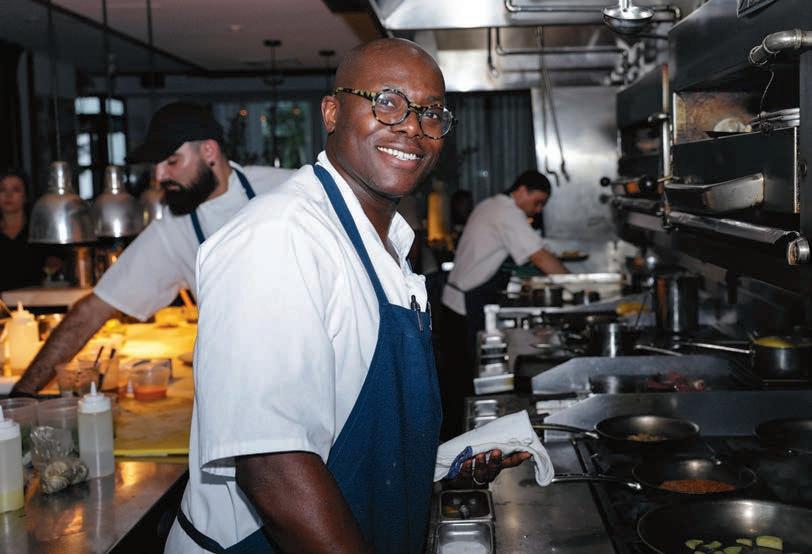
presented, tastes as good as it looks, thanks to the rich, smoky harissa tomato and crisp sugar snap peas.
Sumptuous dessert offerings include rich Basque cheesecake heaped with rhubarb-strawberry compote, moist plum cake with mascarpone and rosemary, and a perfect-ending, espresso-heavy tiramisu.
Co-owned by legendary chef Jody Adams and entrepreneur Eric
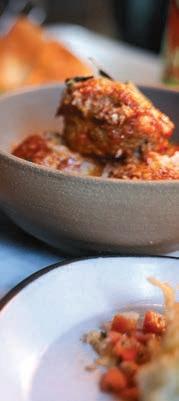
Papachristos under their group A Street Hospitality, Porto has been holding its own since 2016 alongside Trade, La Padrona, The Venetian, and Saloniki. Though they’re one of several high-end, Mediterranean-inspired restaurants under the same umbrella, Porto’s chef and staff are enthusiastic about delivering an authentic, unique dining experience. Service is friendly and prompt, the vibe is upbeat but professional, and the staff, justifiably, seems proud of what’s on offer.
Manager Ned Hajduk says many
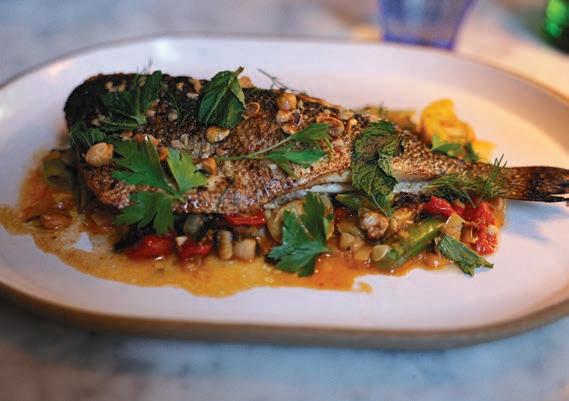
of the diners are regulars. “It’s really a neighborhood restaurant in many ways. On any given night, about 25 percent of the diners are local. The regulars really kept us going during COVID.”
Innovative cocktails, real and mock, keep pace alongside the food. There’s a menu of spritzes, with herb-infused twists on the traditional Aperol and Campari versions. For headier concoctions, try the very smoky Mezcal-based “Who Smokes Anymore,” or go in another direction entirely, and order the violet gin and honey flavored “Lavender Haze.”
If you’re staycationing this summer, treat yourself to a spritz and a feast on Porto’s Amalfi patio for a taste of la vita dolce.
Claire Vail is the editor of MyBoston and a Boston-based writer and photographer who covers culture, food, and travel.
Left: Melon and prosciutto with toasted hazelnuts, Italian meatballs and fried squash blossoms
Middle: The flavorful Bronzino fish, served whole
Right: Scallops with sea beans, couscous, and peach relish
Photographs by Clair Vail


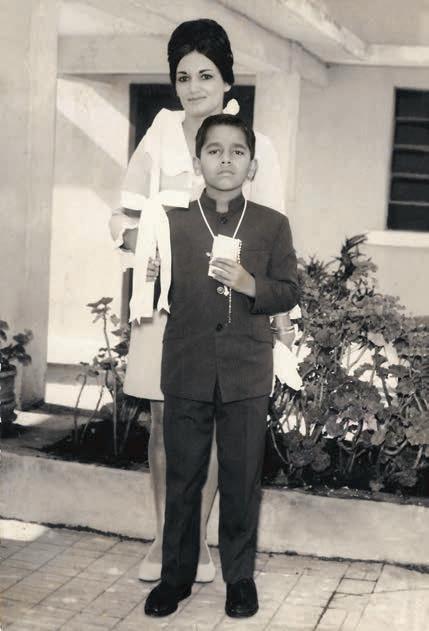


World-renowned architect and Beacon Hill resident Miguel Rosales has designed several of the country’s most iconic bridges, including Boston’s beloved Zakim bridge.
BY CLAIRE VAIL
aARCHITECT MIGUEL ROSALES
likes to give his absolute, undivided attention to the task at hand. Nattily dressed, perfectly composed and seated in the center of an elegant blue sofa in his Beacon Hill brownstone, the country’s most popular bridge designer pauses before responding to questions, weighing each word, to construct precise sentences that span his life story.
Rosales is the inspired mind behind the Leonard P. Zakim Bunker Hill Memorial Bridge, which connects the North End to Charlestown. Since its completion in 2003, it has become one of Boston’s most beloved and iconic sights. The bridge’s name is a bit of a mash-up, as it needed to acknowledge both the cities it brought together: Leonard Paul Zakim was a local Jewish American religious and civil rights leader who fought poverty and racism, while the “Bunker Hill” portion salutes Charlestown’s critical role in the American Revolution. Bostonians tend to call it the Zakim bridge, and Charlestown residents, the Bunker Hill bridge.
By any name, the Zakim bridge is a beauty—a thrilling structure to behold and to drive over, with soaring white steel sail-like stay cables that honor Boston’s maritime history and symbolize its tech-powered future. It gleams at sunrise and sunset, a graceful beacon of American optimism. It’s also a triumph of engineering and urban planning, a bold 1,432 feet long and 300 feet high, planted in the middle of densely
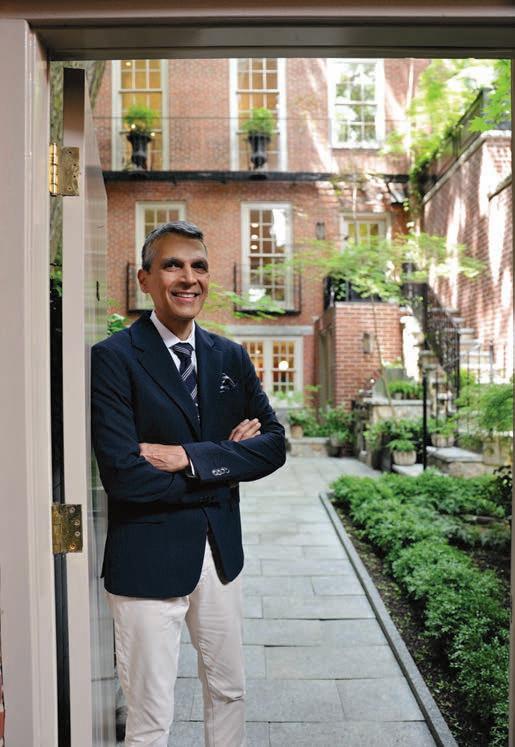
populated, culturally distinct city neighborhoods.
The Zakim bridge was Rosales’ first major project, a significant accomplishment for a young architect, and it catapulted him to the global stage. He has since designed multiple bridges across the U.S. and in Panama. Today, he is sought after for engineering projects that require a balance of technical and aesthetic aspects at a reasonable cost.
Rosales is polite and selfeffacing, with a genteel, almost formal bearing. He grew up in middle-class comfort in Guatemala City, one of four sons in a doting family, a reserved child who kept to himself and preferred to stay inside drawing, thinking and cultivating his many natural gifts.
“My favorite toy was a Spirograph, a toy with gears and a pen you used to draw geometric patterns. It came with a big book of designs, some of which were difficult to do. If the pen skipped, you had to start all over again. I spent countless hours doing that. I did every single design in the book,” he says, chuckling.
Rosales didn’t start out with a particular interest in bridges or plans to come to the U.S. But after earning an architecture degree from the University of Francisco Marroquín in Guatemala in 1985, was encouraged by one of his former professors to continue his studies at Massachusetts Institute of Technology (MIT). It was a huge opportunity.
“How many Guatemalans were coming to Boston in the 1980s to one of the country’s most prestigious universities?” Rosales asks rhetorically. “I can tell you, not many,” he says, with a smile that speaks volumes.
At MIT, Rosales specialized in urban and environmental design, earning a master’s degree in architecture studies in 1987. There, he discovered that he had a deep interest in the intersection of architectural design and urban planning. He worked on the Central Artery Tunnel project in the 1990s, but when other work proved evasive, he founded his own architectural design company, Rosales+, and projects rolled in.

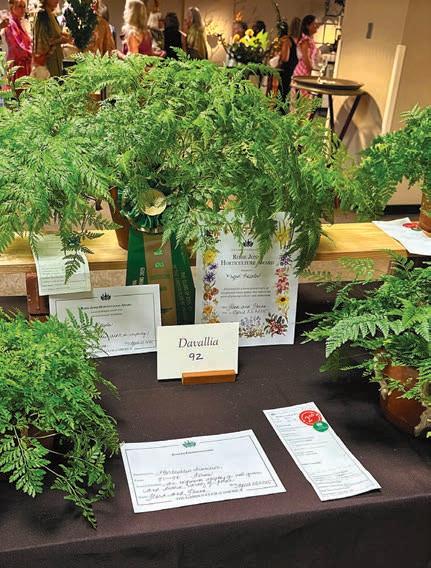
Miguel Rosales’ new hardcover book, “Bridges as Structural Art,” features 268 pages of gorgeous color photographs of 25 bridges he and his firm, Rosales+, have designed. It also includes Rosales’ personal story and information about the process of designing and engineering each structure. You can find the book on Amazon and on the Rosales+ website, www.rosalespartners.com.
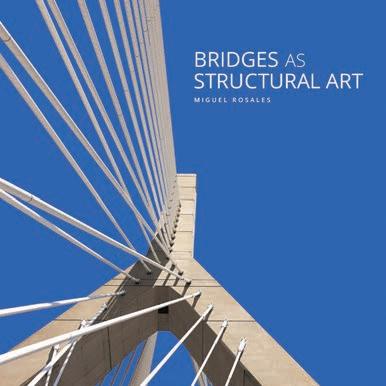
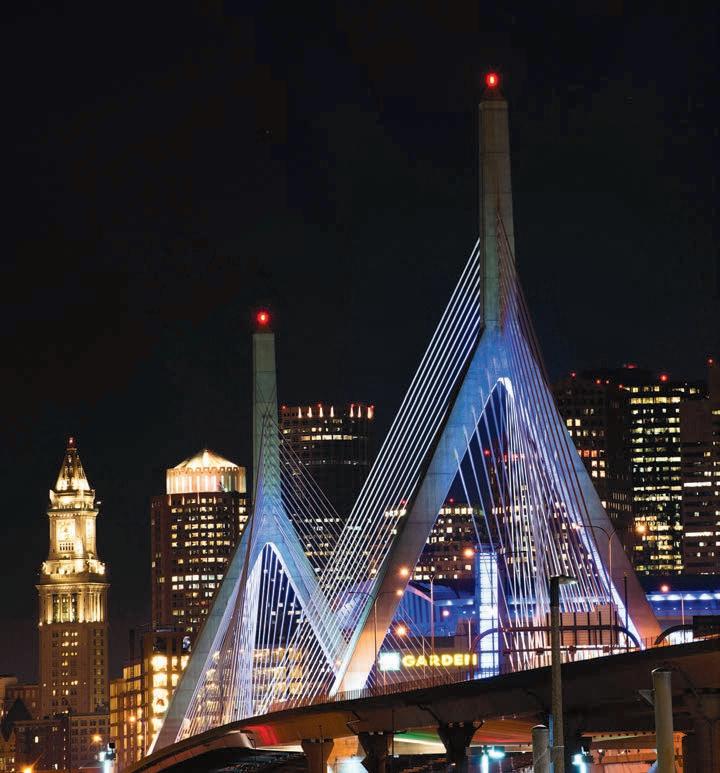
Just as a good bridge can have a positive effect on people and the local economy, a poorly-designed one can cause an uproar. Rosales consults people in the communities where a bridge is planned, and creates 3-D projections early in the design process to ensure he is considering every angle. Aesthetics are a critical dimension: Rosales feels strongly about creating bridges that people find attractive.
“When building a bridge,” he says, “you must consider numerous factors: cost-effectiveness, compliance with all the requirements and constraints, and longevity. A beautiful and expensive design is easy, but budgets can’t support the cost. To make something beautiful and cost-effective is much harder, but if you can do that, that’s a real accomplishment.”
Rosales’s bridges connect humans and transform cities. They shorten
commutes, create green spaces, and change the way residents interact with their surroundings. Notable examples include the stunning, almost undetectable single cable suspension Liberty Bridge in Greenville, South Carolina (2004), the Zakim-like cabled Puente Centenario over the Panama Canal (2004), and the elegant Woodrow Wilson Memorial Bridge in Washington, D.C., a complex counterweight drawbridge, which won the coveted Gustav Lindenthal medal for a single outstanding engineering achievement. All rank high on lists of local people’s favorite structures.
“Many people don’t analyze their response to beauty,” explains Rosales. “It might be the harmonious proportions or distinctive design that catches their eye, but they don’t articulate it in that way. They just intuitively know they find it beautiful.”
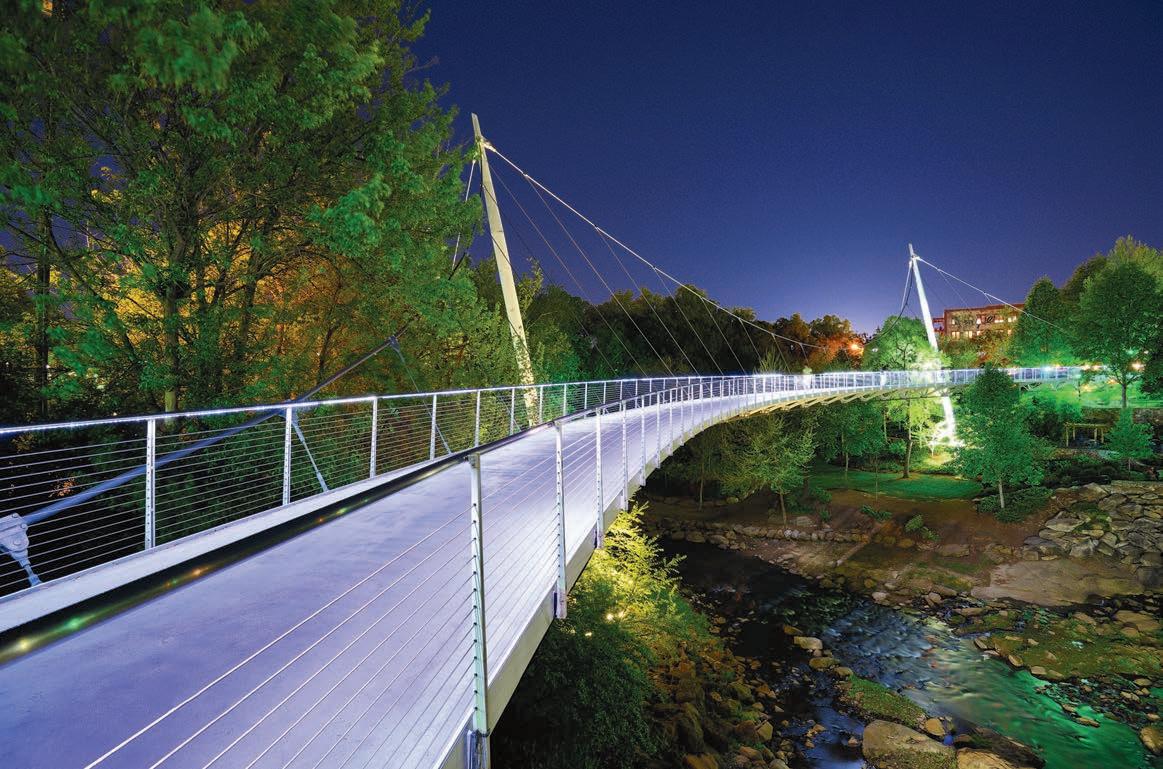
Like the Zakim, Rosales’ Liberty Bridge has a particularly ingenious design. It features a clear, 200-foot pedestrian walkway which seems to float magically over the surging Reedy River. Here, you can almost melt into the landscape, surrounded by panoramic views of the city’s spectacular gardens and glimpses of Greenville’s sparkling city lights. It’s a huge visitor draw, a source of pride for the residents, and a favorite congregation spot for all. People regularly email Rosales to tell him they just got engaged on his bridge.
“They send me photographs of the marriage proposals that happened there,” he offers modestly, his eyes gentle. “These moments bring me a lot of satisfaction. The bridge is clearly a special place for people, which is truly amazing.”
Between 2012 and 2018, Rosales designed multiple pedestrian bridges in Texas and Massachusetts, including the Phyllis J. Tilly Memorial Bridge in Fort Worth and Boston’s Frances
Appleton Bridge. He also oversaw restoration of the Longfellow bridge, which had deteriorated due to a lack of maintenance over half a century.
At Rosales’ six-story brownstone, which he shares with his husband, John Corey, a preservation expert, the elegant rooms are traditionally designed, containing few objects that don’t have a practical use. Two silver bowls rest symmetrically on a mantlepiece. Framed paintings of historical ships hang on the walls. It’s silent except for the dignified chime of a clock, precisely on the hour.
Their back garden is a gem, one of the stops on the Hidden Gardens of Beacon Hill tour. Golden afternoon light filters through the leaves overhead, dappling the patio. Rosales points out the large tree that towers above the house, which he says turns spectacular colors in the fall. He has recently begin cultivating his own plants, several of which are displayed in neat rows on the steps
leading to the balcony. He selects one, cradling it in his hands like an infant, and explains that it’s a deer foot fern he nurtured for three years, which won the 2025 Garden Club of America’s Rosie Jones Horticultural Award, a prize given for plants that demonstrate exceptional and inspiring visual appeal.
The garden is a private oasis for Rosales, a place to reflect and bask in the beauty of nature, shaped by his own hands.
“When I was studying architecture in Guatemala, a professor said to me, ‘to be a good architect, you have to surround yourself with places and objects that are aesthetically beautiful, because then you’ll understand their qualities, their components.’ I try to follow this practice, both in my life and in my work.”
Claire Vail is the editor of MyBoston and a Boston-based writer and photographer who covers culture, food, and travel.

Newbury Street-based optometrist Blink offers a remarkably unique collection of eyeglass frames, sourced from designers around the world.
BY CLAIRE VAIL
aA PAIR OF MODERN, canary-colored chairs outside Blink, a boutique optometrist practice on Newbury Street led by Dr. Stacy Coen, OD, signal to strollers-by that something fun and artsy is happening inside. And it is—Blink offers the city’s most distinctive collection of eyeglass frames, sourced from artisans around the world, with options so appealing that shopping for the right pair of glasses here feels a bit like picking out the perfect engagement ring.
On any given day, Coen and optician Dennis Limon sit side by side at the counter, welcoming patients and visitors into the intimate space with bright smiles and friendly chit chat. Not only do they get along, but they also enjoy that rare kind of business partnership in which each of them fuels, rather than competes with, the other’s creative abilities.
Together they designed the ping pong table display in the center of the room, with paddles featuring
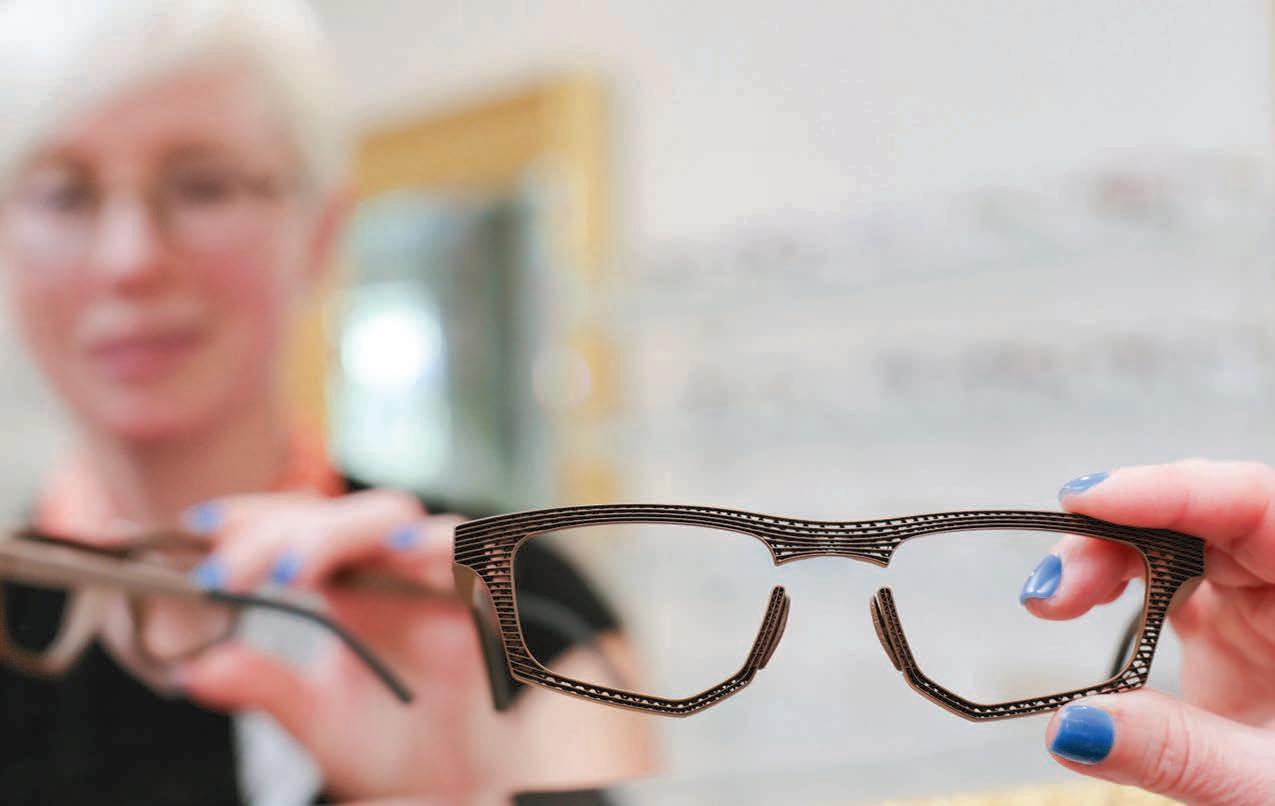
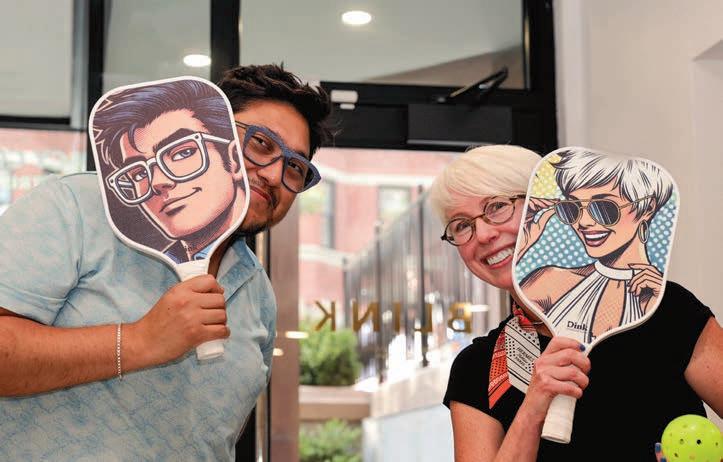
pop-art versions of their faces and funky red-and-black sunglasses draped over the netting. Baroque antique mirrors restored by Coen’s craftsman father add a luxe touch. The display changes with the seasons, but Coen and Limon’s delight in playful design is a permanent fixture.
As you might expect, the frames that line Blink’s shelves are not your typical plastic and metal variety. Eyeglasses date back to the 13th century, and metal frames to the 18th century, long before plastics were invented. Blink’s inventory features the raw materials of earlier times, such as wood, stone and leather, forged in old world countries by very fashionforward designers.
There are also frames made from titanium, water buffalo horn and shagreen (stingray), and a few 3D-printed options. The frames are all shapes and sizes, some dramatic, others demure—all different, all waiting for the right personality to come along. There are velvety aqua shagreen frames that should be sauntering poolside at a pop star’s Miami villa, polished wood spectacles with dramatic arches that would balance perfectly on an architect’s nose, and a to-die-for granite pair that sparkles like pave diamonds, destined to be some lucky girl’s or guy’s best friend.
Many of Blink’s frames can be customized according to a buyer’s whim.
“You can have gold or turquoise elements added in these spaces, wherever you like,” says Coen, indicating the intricate web of holes in a 3-D frame. “We can do almost anything people want to give glasses a personal look and feel.”
“Whenever we customize a piece for someone, it’s special, because they’re part of the creative process,” says Limon.
He tells the story of a man who wanted an inscription etched inside the temple, the part of the frame that goes over the ear.
“We asked him if there was a
message that spoke deeply to him. He thought about it for a long time, and then he finally came up with it.”
What was the mantra? “Listen More,” says Limon, smiling.
Limon and Coen travel around the world sourcing the most unique designs possible. They are sticklers for serious craftmanship, and they have a great time collaborating with likeminded artists.
“When we first met with the guy who now makes our leather frames, we ended up having drinks and hanging out with him for two hours, designing several frames, because they’re made to order.”
Bespoke endpiece embellishments (a little bling on the edge of the upper rims) provide another opportunity to illustrate a personal story, much in the way people get tattoos to memorialize a meaningful experience.
Coen mentions one maker of frames who puts a signature gold disc on the endpieces. When she ran into the designer at a conference in New York, she asked if there was a story there. The artist explained that she came from a family frame business that went way back. When her grandfather once made a pair of glasses for her grandmother, he placed a small pearl on the endpiece.
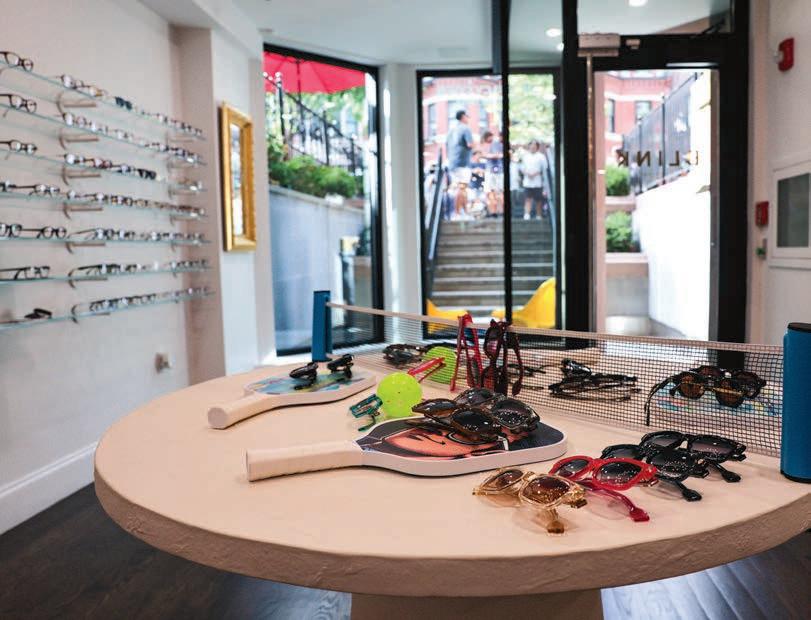
The gold disc, she explained, is a tribute to her grandparents.
While their focus is on helping patients see the world clearly, both Coen and Limon believe that achieving the right aesthetic is critical to a person’s sense of self.
“Dennis and I love to help people find frames that express their individuality,” says Coen. “We match frames to faces.”
Limon agrees. “It’s always funny how one of the hardest things for people to gauge is whether they like how they look in new frames,” he says. “But we’re, like, ‘Oh, they smiled in that one.’ And it’s usually the funkier frame, too.”
Both Coen and Limon own multiple pairs of glasses themselves, including some of the more intriguing and eccentric styles. They like to experiment with new looks and aren’t afraid push the boundaries of interesting design.
“When you have something that’s made from quality work and it’s comfortable, you look forward to wearing it every day—it’s a joy to put on your face,” says Coen. “It becomes part of you.”
Claire Vail is the editor of MyBoston and a Boston-based writer and photographer who covers culture, food, and travel.
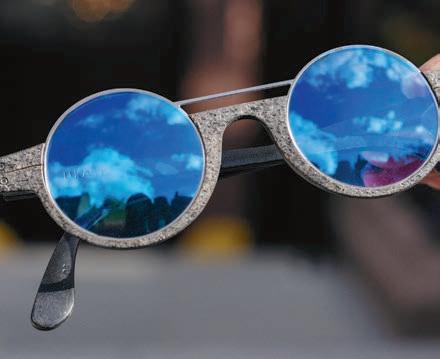
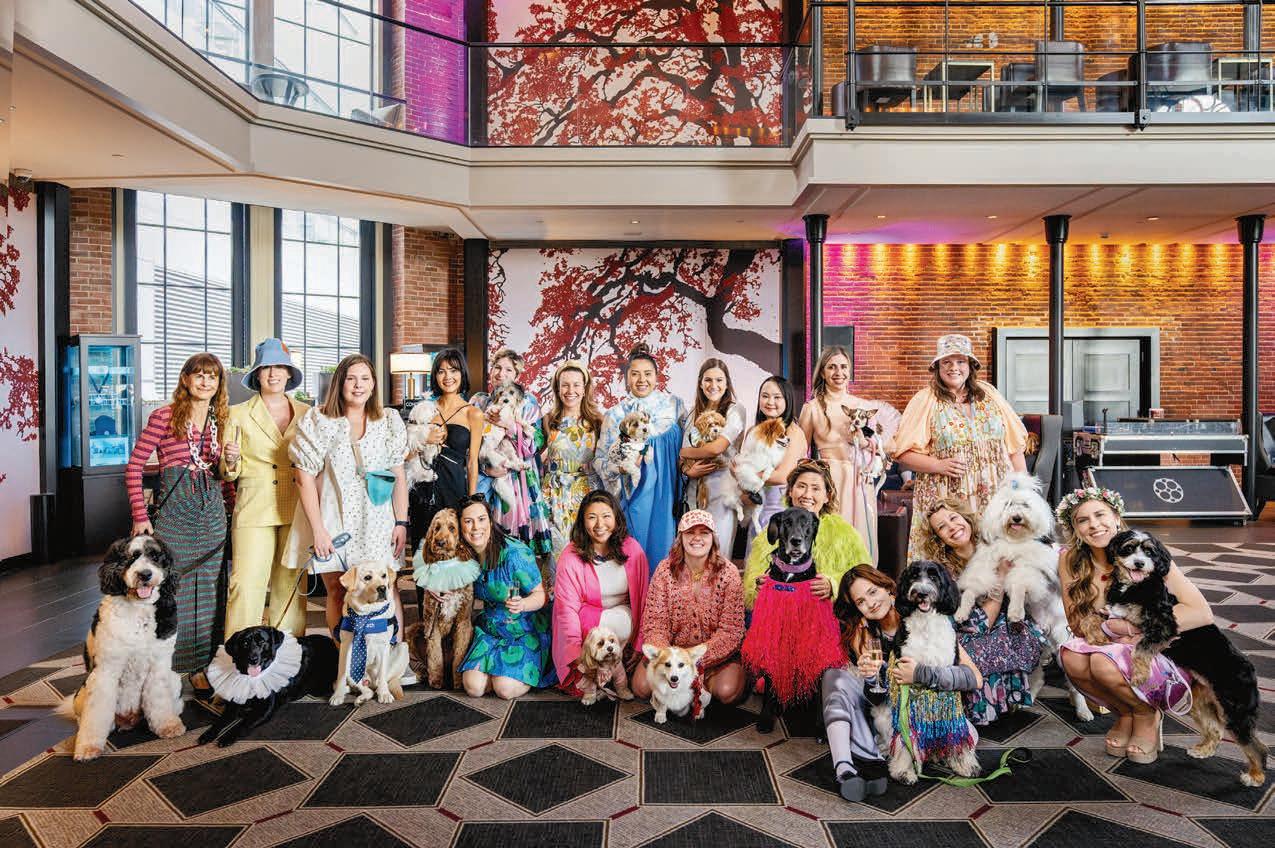

How do dogs bring us together?
Let me count the ways.
BY LISA MULMAN
IIF YOU FREQUENT BACK BAY, Beacon Hill or the South End, there’s a good chance you’ve encountered me and my dog, Satchel. His large, teddybear-like head, lumbering gait, and fluffy black-and-white coat turn heads. Naturally, questions ensue.
From the very young: “Is that a cow?” (Ha! He’s my city cow.)
From the information-minded: “What breed is he?” “How old is he?” “How much does he weigh?” (Saint Bernard/Standard Poodle mix; 8; 110 pounds.)
From the curious: “Does he eat a lot” (No, surprisingly.)
Rarely does anyone ask if he’s friendly, because within seconds of hearing “you are the most adorable thing I’ve ever seen,” he’ll snuggle up for some pets.
Satchel isn’t just a fixture of the neighborhood—he’s a conduit for kindness and connection.
After living in the Back Bay and, most recently, the South End, I’m convinced that Satchel is part of a vast canine conspiracy whose mission is to mend the growing tears in the fabric

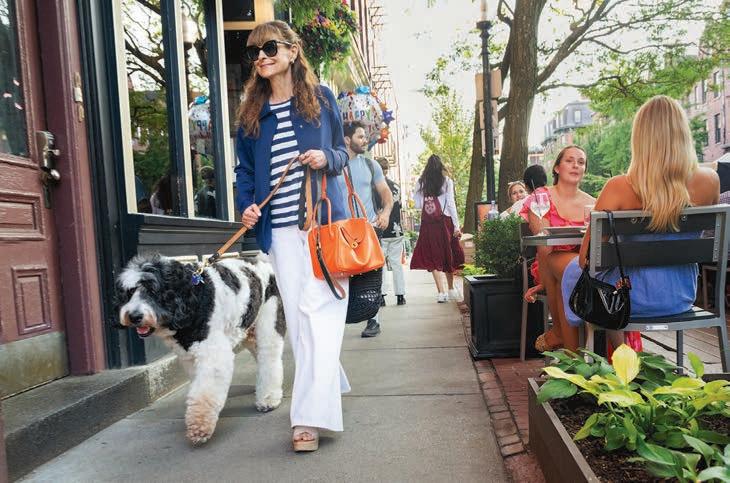
of our culture; to forge friendships between people who would otherwise never have noticed one another; to combat an increasing epidemic of loneliness; and to spread generosity and dignity. Sounds like a tall order, I know. But if you own or know a city dog, you know this is true.
My own unexpected journey from a career as a professor of European literature to the owner of a Back Bay dog spa is proof of the conspiracy in action. Let me explain.
It began during the COVID-19 pandemic, that terrible time. I was starting cancer treatment and my husband and I had abandoned our apartment on Commonwealth Avenue for the safety of our second home in Vermont. Since I am temperamentally designed for urban life, I found it difficult to spend whole days (weeks! months!) seeing no one but my husband and, of course, Satchel.
Satchel, on the other hand, used the time to indulge the more philosophical aspects of his personality. He filled the long hours by sitting perfectly still on one side of the patio near a stone pillar, in a pose that we affectionately called “dog-goyle.”
The lack of interaction with other people pained me. We would go for long walks on the nearby country club golf course, letting him run on the now-desolate lawn. When we did see another person, we’d keep our
lonely distance, waving to one another across the green, perfectly manicured expanse.
The real sadness, however, kicked in when we would drive down to Boston for my treatments. Seeing the empty spaces made me truly heartsick. Where were the school children? Where was the man playing his stringed instrument in the Public Garden? Where were all the tourists lining up outside Zara and the Adidas Store? Where were the dogs?
Actually, the dogs and their people were the only ones who did pop out from seclusion, since taking one’s dog out so it can relieve itself isn’t optional. As we gradually came back to Boston more often, we realized that walking Satchel wasn’t only necessary, it was a lifeline. Neighbors and strangers with dogs would inch ever closer to one another (still masked of course) to have conversations. The awful aloneness started to recede. Satchel came out of his meditative shell, as did we all.
It struck me that our dogs were fundamental connectors, even when connecting could be unsafe. So, my husband and I opened Onyva, a Back Bay dog grooming business. We made it a community space, with an art gallery, coffee and snacks, and lots of opportunities for community building

(the thing that dogs do best).
Now the city is again filled with dog owners who are interacting, discovering commonalities, and forming connections. It happens to me, too. I’ll share are a few moments with Satchel where one thing led to another.
• While getting coffee at The Thinking Cup, we spy an adorable, super-fluffy strawberry-blonde puppy scampering around on the patio. I run up to pet him, and it turns out that this young dog—Bingo is his name—is on his way to his first groom, at my shop, Onyva. I talk with Bingo’s mom, and learn she’s starting a women’s clothing business. I introduce her to my friends, and she introduces me to hers. We all meet for cocktails and networking. She goes on to be fabulously successful (not a surprise). I had coffee with her yesterday, and she told me, “It all started with Bingo.”
• I bring Satchel to one of my favorite boutiques on Charles Street. The owner is smitten with him, and I am smitten with her. We decide to put on a dog fashion show. She curates fabulous clothes for the owners. We put matching accessories on the bigger dogs, great little outfits on the little ones (made for them especially by another incredible local female designer). We hold it at the Liberty Hotel. It’s a hit!
• I meet a woman who is the founder of a nonprofit that provides a day
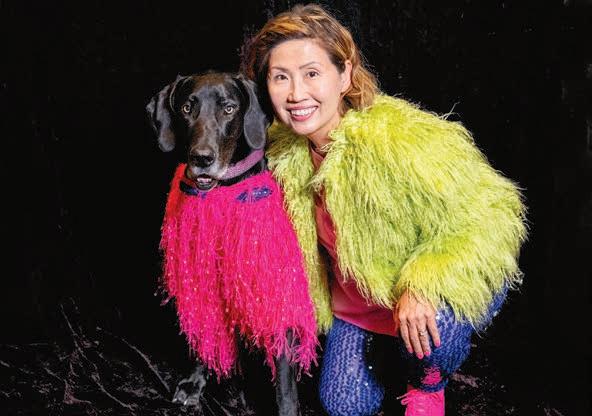
program for young people on the autism spectrum. Turns out her son, who is nonverbal, is a wonderful artist. I offer to have him do an exhibition at Onyva’s art gallery. At the reception, people buy art, play with dogs, smile, and get to know each other.
• We notice that a very popular Beacon Hill dog walker has a lot of great photographs of Beacon Hill/Back Bay dogs on Instagram. We offer to showcase his work in our gallery. At the opening, we meet many of the dogs and owners featured in the photos, some of whom have been his clients for over 15 years. We also hear stories of dogs who have passed away, and everyone shares their memories of not only the neighborhood dogs, but also the neighborhood itself, over the years. Later, he is encouraged and
inspired to make a calendar of his photographs, which is currently for sale at Onyva.
These are just a few examples of how Satchel and his friends help me to reach across the imaginary divides that can make the city feel like a cold place. The intrinsic friendliness of dogs brings out the best in all of us. So don’t be surprised when you discover that some magical relationship in your life can be traced back to a canine companion.
Lisa Mulman is a cofounder of Onyva, Newbury Street’s premier dog grooming business. Previously, she was a tenured professor of literature at Salem State University. She is the proud pet parent of Satchel, a 110-pound St. Bernadoodle and the inspiration for the Onyva enterprise.


Nearly 125 years ago, James H. Doyle, great-grandfather of DOYLE CEO Laura Doyle, first took up the gavel in Boston as Chairman of the Board of Aldermen. Generations later, DOYLE returned to the city with a pop-up on Clarendon Street. Now, the company is putting down roots.
This fall, DOYLE will open its permanent home at The Vendome, 290 Dartmouth Street in Back Bay. The tradition of Doyles and gavels in Boston continues – and future generations are invited to be part of it.
INFORMATION & APPOINTMENTS
Chris Barber
VP, Director, American Furniture & Decorative Arts American@Doyle.com 617-733-1232
Kathryn Craig
VP, Director of Boston Operations Boston@Doyle.com 617-999-8254
DOYLE Boston
290 Dartmouth Street Boston, MA 02116
Opening this Fall
signature, Boston’s Best 2025 – just got even better.
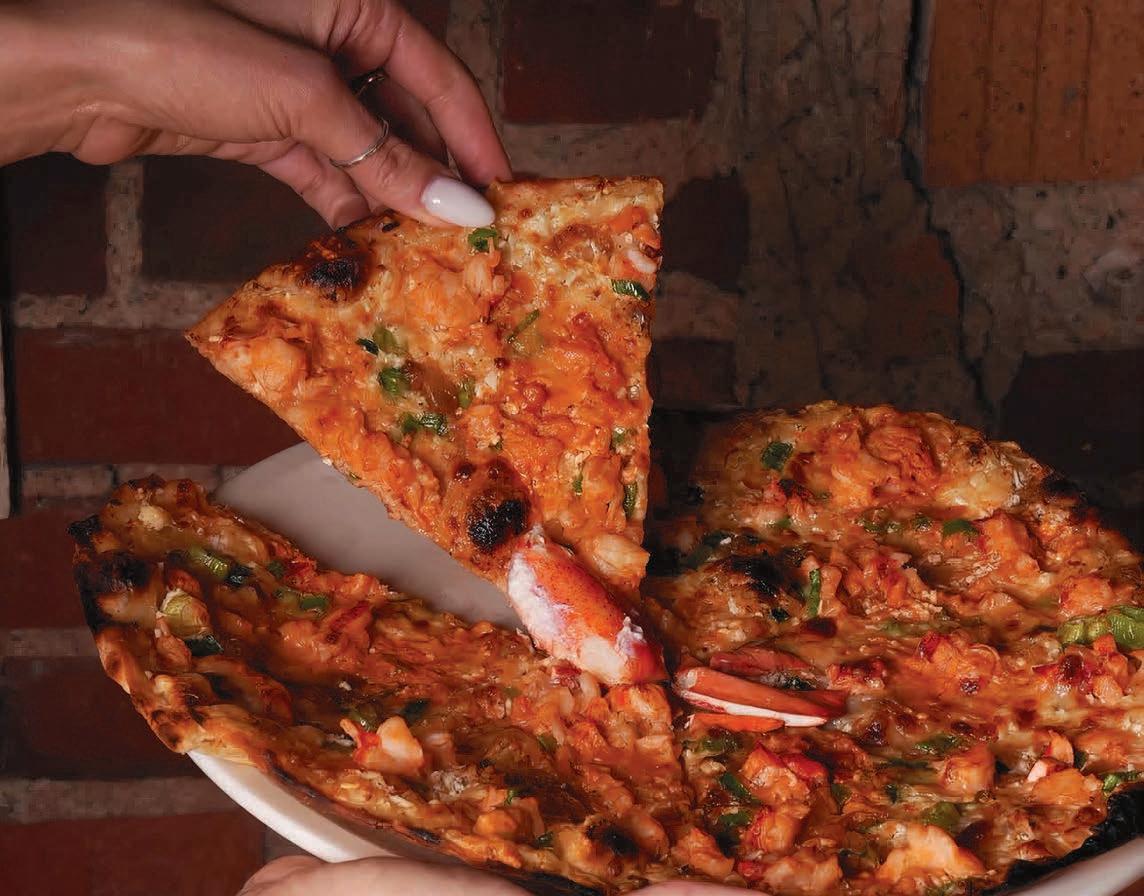
For a limited time, we’re pairing it with a full bottle of your choice: Crisp Sauvignon Blanc or Bold Cabernet. One iconic pizza. One perfect bottle. Just $55.
Perfect for date night, a decadent catch-up with friends, or treating yourself because you can. *Available at the bar for dine-in only – 7 days a week* Boston’s most talked-about lobster pizza –



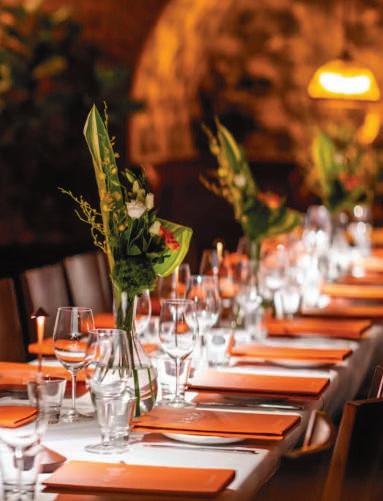
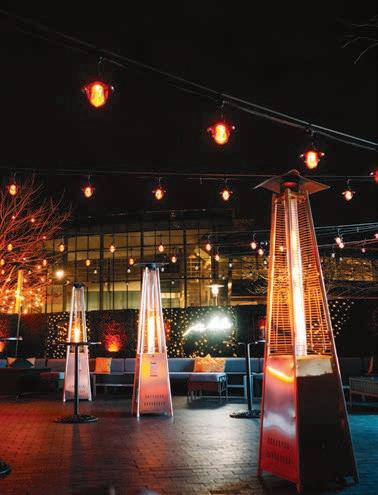

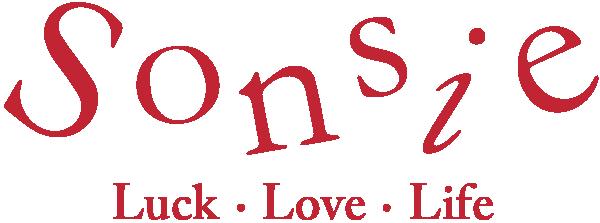






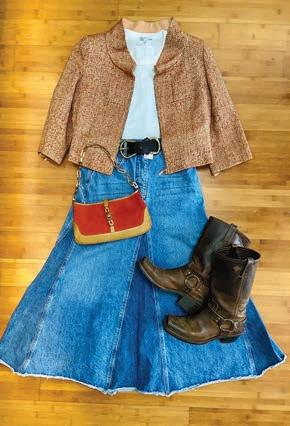
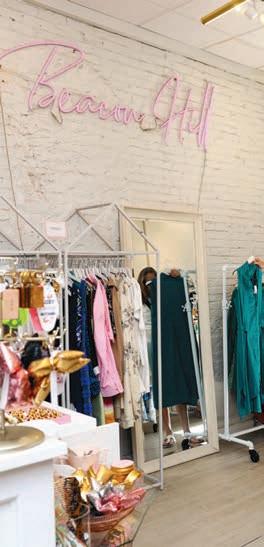
Take a fashion journey through time and uncover your next favorite find at these must-visit consignment shops—where personal style meets timeless charm.
BY SARAH McMANUS
109 Charles St. and 176 Newbury St. Covet is a trendy twist on resale. Step inside and you’re greeted by bright colors and a well-chosen mix of mid- to high-end labels—all at price points that blend high and low seamlessly. Think Mango meets Max Mara. The finds are fresh, covetable, and you won’t leave empty-handed.
✱ Insider Tip: Follow them on social for first dibs on exclusive drops, sales, and can’t-miss pieces.
20 Myrtle St.
Tucked away on Myrtle Street, Houndstooth is a neighborhood gem beloved by its stylish Beacon Hill community. An extension of their larger North Shore location, this boutique rotates enviable staples for day or night. From Tiffany & Co. to playful costume jewels, there’s
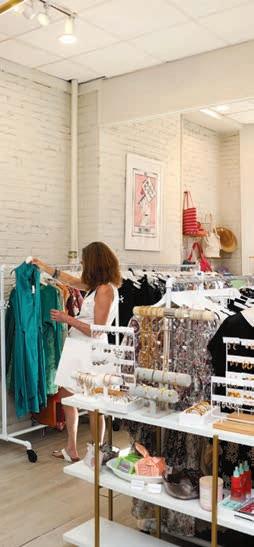
something for every moment. The shop isn’t overwhelming—it’s cozy, making space for your own personal styling session.
✱ Insider Tip: Check out the millennial dream wall: a lineup of Louboutin pumps.
169 and 262 Newbury St.
Walking into Revolve feels like stepping into a celebrity closet— think glam, modern pieces straight off your social feed. The shop’s second Newbury location focuses on high-end designer shoes, bags, and to-die-for jewelry from the likes of Chanel and Cartier. Don’t forget to say “hi” to Penny, the resident doodle, before you go.
✱ Insider Tip: Swing by often— fresh picks hit the floor daily, and no visit is ever the same.

100 Charles St.
At Vintage Taste, every piece is curated with a sharp eye for rare finds. The clothing is statement-making—no digging required. Expect Balenciaga, Gucci, and Prada on beautifully organized racks. This is consignment, elevated.
✱ Insider Tip: There’s plenty for the gents too, with a full floor of silk ties, crisp suit jackets, and sleek dress shoes.
332 Newbury St.
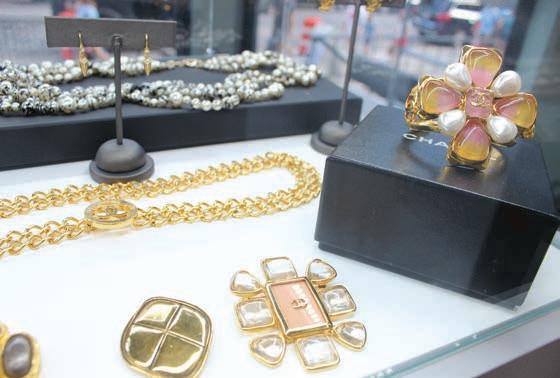
A cool addition to Back Bay, Vivant Vintage has a nostalgic vibe with a wall of retro denim, slip dresses, and unique accessories for any silver lover. Don’t miss the old-school photo booth on your way out.
✱ Insider Tip: Book an appointment to browse the gold jewelry edit.
Sarah McManus is a fashion writer, and the owner of Dog Eat Cake, an online boutique pet bakery based in Boston that caters to man or woman’s best friend.
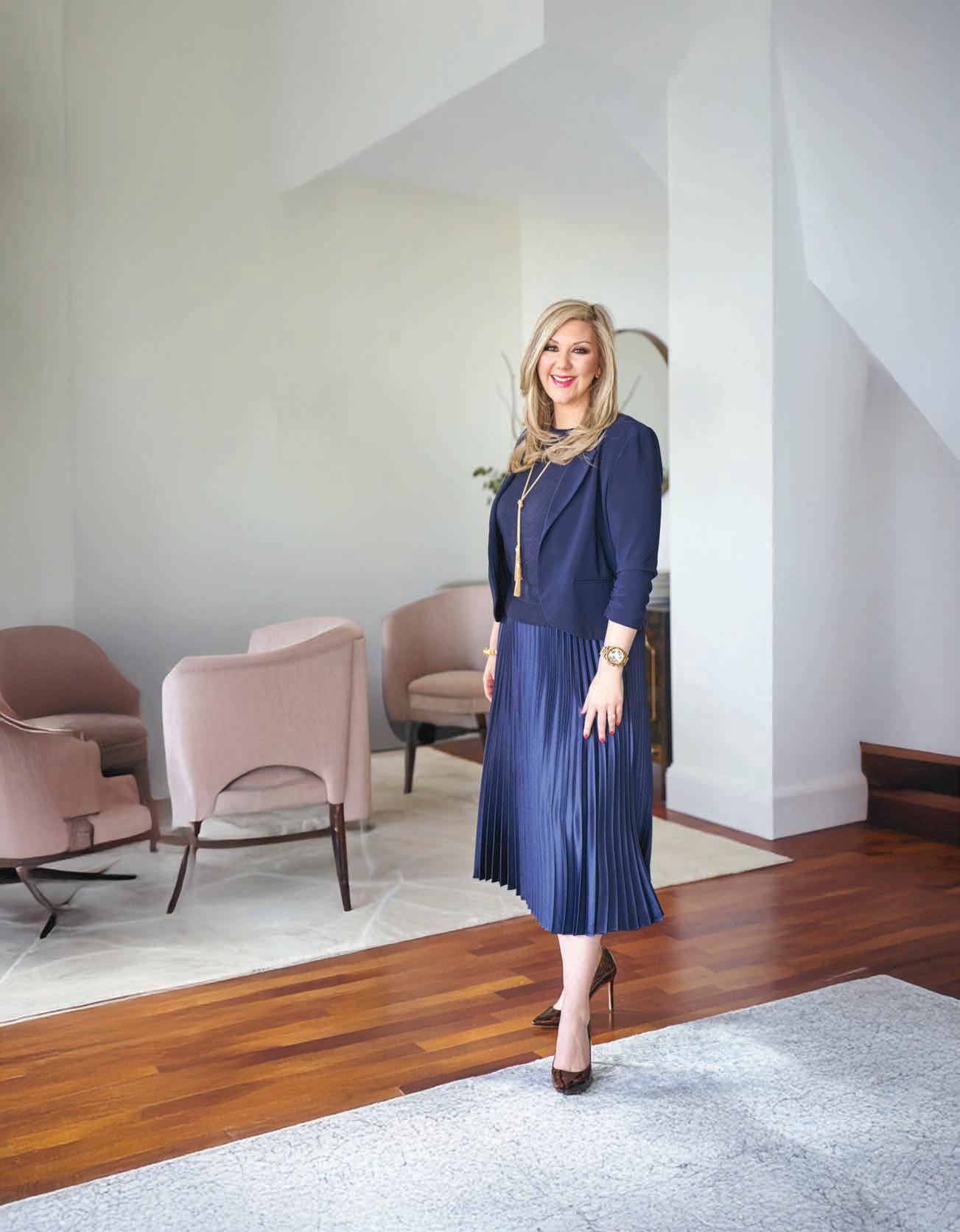
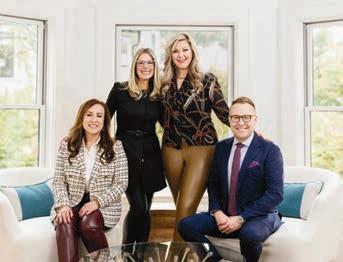
The Homelessness Task Force of the Neighborhood Association of the Back Bay is hosting two upcoming events.
BY KATHY YOUNG AND ELISABETH MORRIS
BOSTON HAS some of the most beautiful neighborhoods and homes in the country, but there are unhoused people who need our help. The Homelessness Task Force (HTF) of the Neighborhood Association of the Back Bay (NABB) works to find solutions. Since 2019, a congenial group of Back Bay residents has banded together to learn more about what causes homelessness and to promote effective programs to prevent street homelessness.
As federal funding for affordable housing has decreased over the last four decades, Boston has made
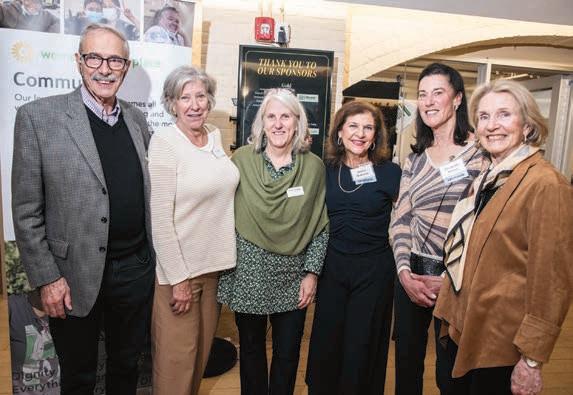
considerable investments in affordable and supportive housing. The number of people in Boston who exited homelessness to permanent housing last year was 2,838.
“According to the national census of the homeless, Boston consistently has one of the lowest street homeless populations in the country,” says Elisabeth Morris, co-chair of the HTF.
Kathy Young notes, “Boston has very professional organizations working to develop alternatives for the needy in our midst. Unfortunately, the need for affordable and supportive housing is much greater than the supply.”

September 18, 5:30 p.m.
Copley Central Branch of Boston Public Library
The NABB Public Forum on Housing and Homelessness will present the city’s experiences with affordable and supportive housing in Boston neighborhoods. Panelists will include Boston’s Chief of Housing Sheila Dillon, Executive Director of the Pine Street Inn Lyndia Downie, formerly homeless people, and others. Lynn Jolicoeur of WBUR will moderate.
November 13, 6-8:30 p.m.
The NABB Homelessness Task Force will partner with the Women’s Lunch Place to produce the fifth annual Harvest Festival & Auction. This is a chance for neighbors from Back Bay and abutting neighborhoods to connect over a gourmet buffet, with specialty beverages and unique auction items. To help with corporate and individual sponsorships or auction items, visit www.womenslunchplace.org/nabb.



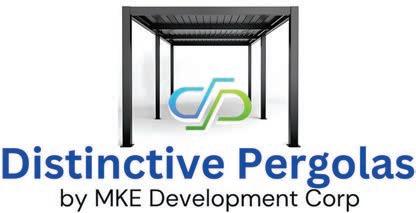

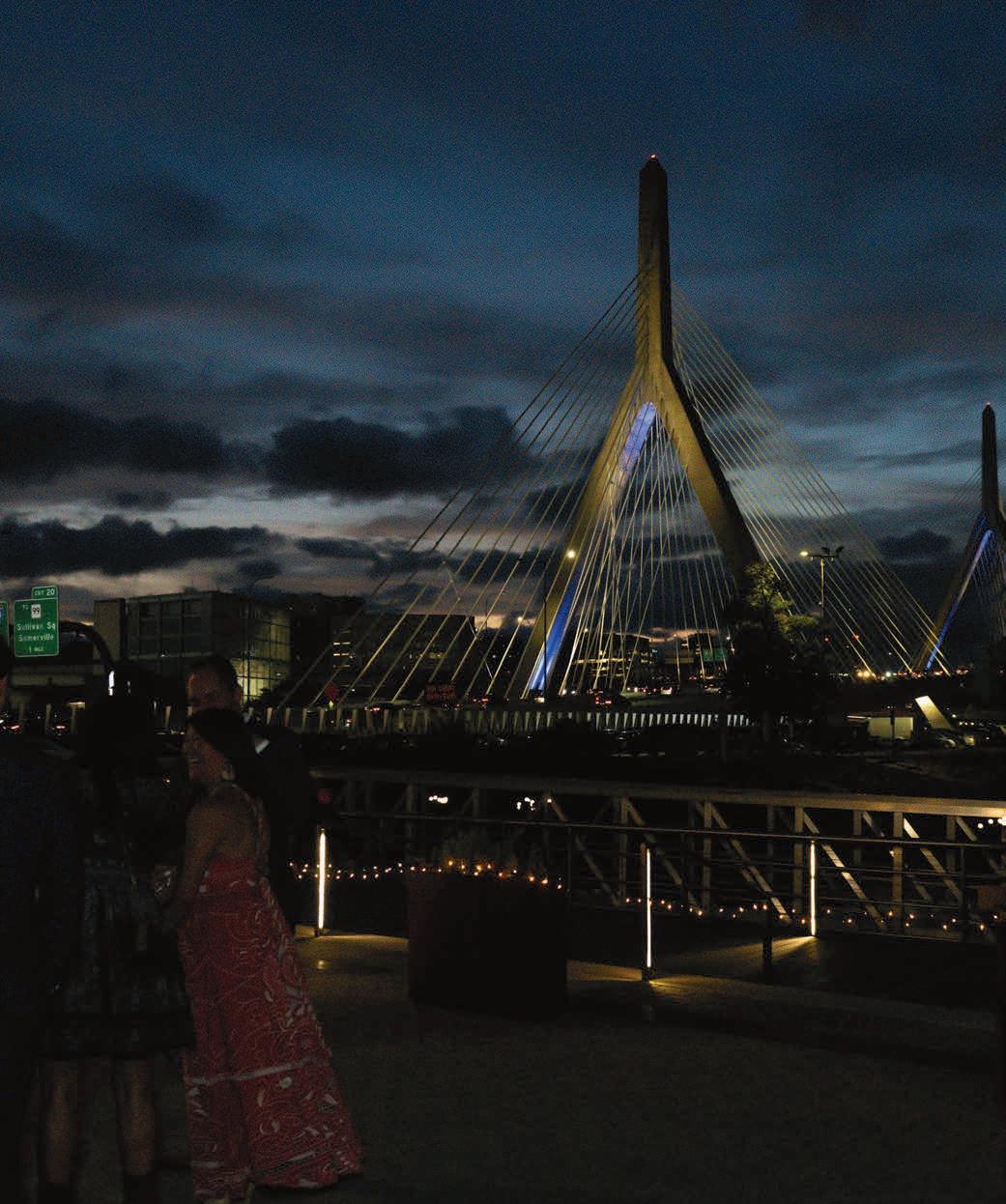

Silke Berlinghof-Nielsen brings her cultivated eye and multilingual background to her curated online antique furniture marketplace, Styylish.com.
BY MYBOSTON STAFF
What inspired your interest in antique furniture?
As early as I can remember, I was surrounded by antique furniture. I come from a long line of antiques dealers in Heidelberg, Germany. My great-grandfather started the business, and most of his seven children followed in his footsteps, opening their own antique shops in Heidelberg. As a child, I spent time in my grandmother’s store in the Old Town. I vividly remember sketching the inlay patterns of Baroque furniture instead of the usual flowers or animals. I think that’s when my love for antiques truly began.
Do you specialize in a particular period or category of furniture?
I have a deep appreciation for 19thcentury Biedermeier furniture and 18th-century German Baroque pieces. At the same time, I admire the refined craftsmanship of French 18th-century Louis XV and Louis XVI styles. The elegant wood grain of Biedermeier furniture and the intricate inlay work found in 18th-century pieces continue to fascinate me.
Can antique pieces work in small, modern spaces?
Absolutely. Every space has room for an antique. In a modern interior, a Biedermeier side table or an 18thcentury chest of drawers can become
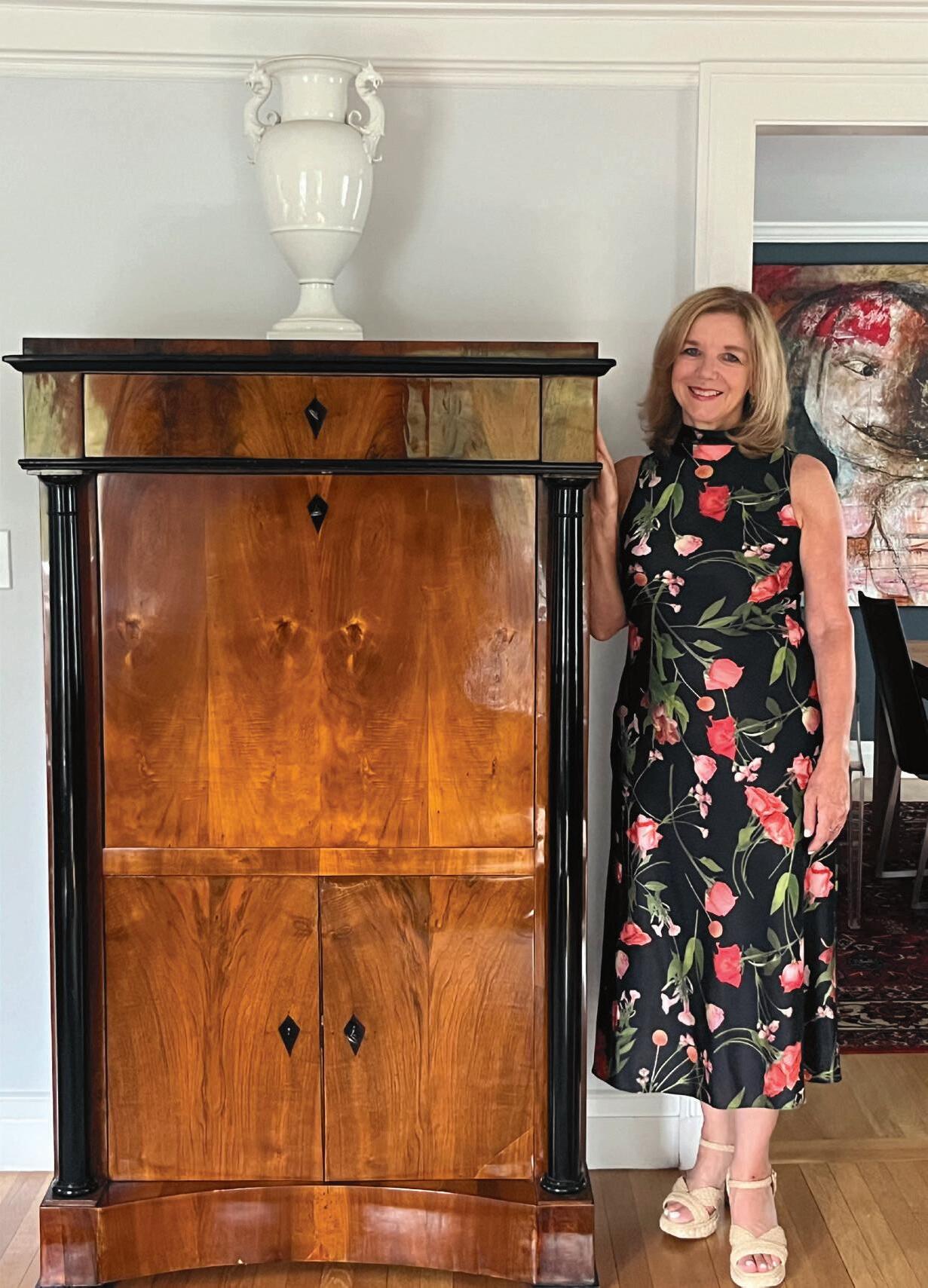
a striking focal point. I believe in mixing periods to create contrast and character—pairing historical pieces with clean lines or bold contemporary design. That philosophy also guides my work with my online store, Styylish, where I offer a curated selection of antiques and distinctive contemporary pieces that speak to one another across time.
Can you describe a few of the pieces you’re most excited about?
I’m especially excited about a Neoclassical dresser that just arrived from Germany. It’s an extraordinary piece, showcasing exquisite geometric inlay work. The ébéniste used several types of wood to create beautifully intricate patterns. Another favorite is a Biedermeier side table from the early 19th century. It’s a perfect example of the period’s refined craftsmanship and timeless appeal. The round tabletop features a meticulously crafted
piecrust walnut veneer, highlighted by a central medallion that draws the eye. Finally, I’d like to highlight an 18th-century German Baroque chest of drawers featuring a gracefully curved front and exquisite walnut veneer with intricate marquetry inlay in plum wood and bird’s-eye maple on all sides and the top. The warm tones of the walnut, combined with the elaborate inlay work, make this piece a true statement of timeless elegance.
Silke Berlinghof-Nielsen is a Belmontbased antique expert and art historian with a master’s degree in art history and a lifelong connection to the European art world. Raised in a family of antiques dealers in Heidelberg, Germany, she worked as an auctioneer and art expert before moving to the U.S.





After the terrorist attacks of September 11, 2001, novelists explored themes of trauma, uncertainty, and identity, trying to make sense of the new “normal.”
BY PAUL SCHEUFELE
TWENTY-FOUR YEARS AGO this month, the tragic events of September 11 reshaped the geopolitical landscape and altered our perspective on everything. Americans struggled to grasp the unthinkable. Over time, literature helped make the ineffable understandable and sparked a new literary genre—the post-9/11 novel. Here are five works that define this genre— books you read slowly, ponder deeply, and discuss passionately—just as we shelve our beach books.
SATURDAY by Ian McEwan (2005)
In a single day in London, neurosurgeon Henry Perowne is called to save the life of a man who threatens violence against his family. McEwan highlights the era’s increased sense of vulnerability and


moral uncertainty, and how terrorism and the Iraq War influenced private life, intensifying fear and reshaping morality.
by John Updike (2006)
An American-born Muslim teenager, Ahmad Ashmawy Mulloy, son of an IrishAmerican mother and an absent Egyptian father, is radicalized by a charismatic Imam in New Jersey and becomes involved in a terrorist plot against New York City. Updike faced widespread criticism for reinforcing Islamophobic stereotypes, but the novel ignited conversations about isolation, alienation, and the roots of fear in America after 9/11.
by Don DeLillo (2007)
After surviving the collapse of the Twin Towers, lawyer Keith Neudecker struggles to process his trauma, psychological disorientation, and emotional detachment. DeLillo’s fragmented writing style mirrors survivors’ disorientation and examines how catastrophe changes identities and relationships.
THE RELUCTANT FUNDAMENTALIST by Mohsin Hamid (2007)
Sitting in a Lahore café across from a mysterious American, Changez recounts his years in America as a Princeton graduate and mergers and acquisitions expert, only to become disillusioned with the American dream after 9/11. Hamid explores identity, perception, and the uneasy relationship between East and West, leaving readers to question whom can be trusted.
by Joseph O’Neill (2008)
Hans van den Broek is transferred from his prestigious bank’s London office to New York before 9/11, expecting to thrive in the financial hub with his wife, Rachel, and their baby. But when the towers fall, Rachel returns to London, and Hans befriends a Trinidadian named Chuck, drifting into the world of Brooklyn cricket leagues. O’Neill weaves immigrant experience, friendship, and loss into a reflection on belonging and the American dream amid the city’s altered landscape.
Paul Scheufele (pronounced Shife’-Lee) is the author of “Damaged Goods,” a characterdriven novel that explores ethical dilemmas, family secrets, and the choices that can change everything. A native of Needham, Paul now lives in the Back Bay and Truro. Learn more at paulscheufele.com.
Local book clubs! Would you like to recommend favorite books to our readers? Reach out to editor@mybostonmag.com.


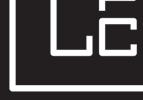
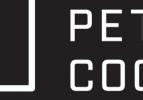


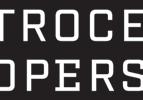
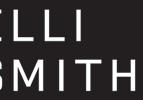
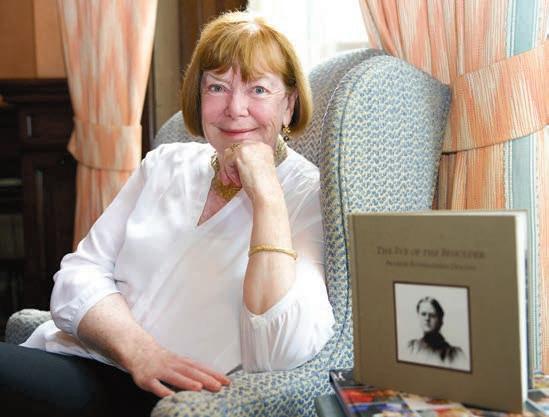


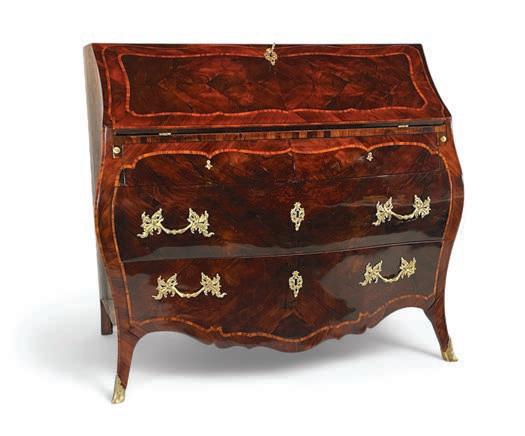

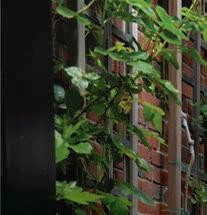



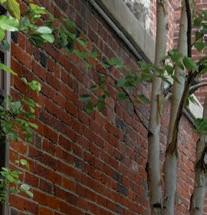

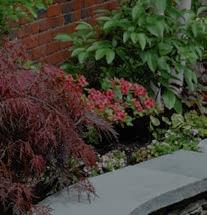
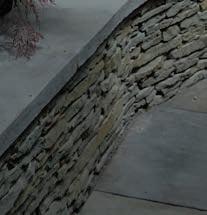



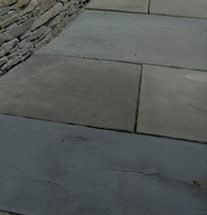
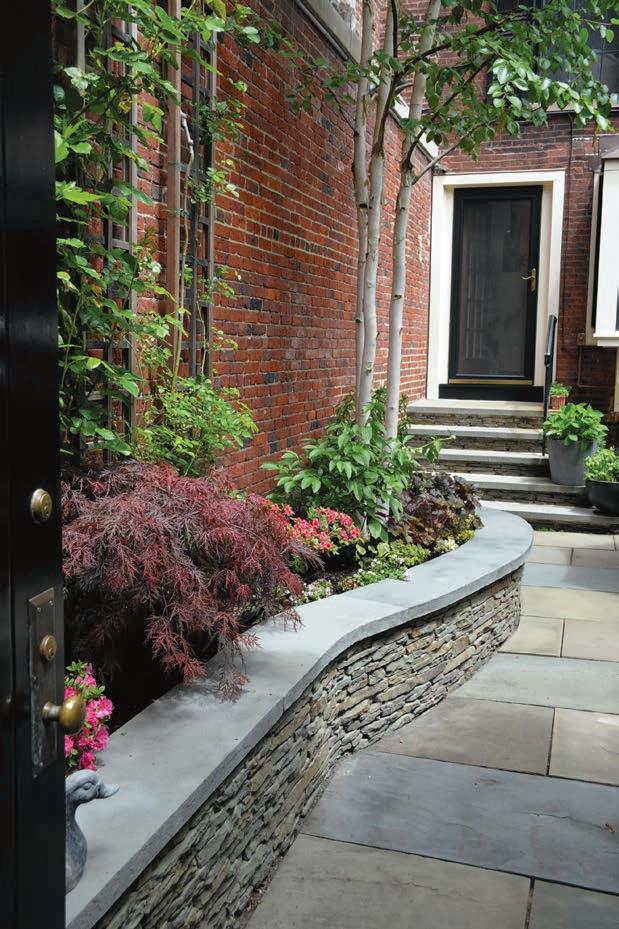
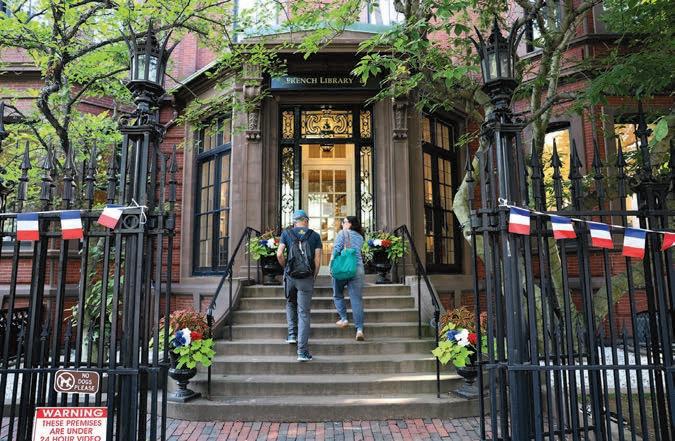
ON JULY 13, MEMBERS and guests of the French Library gathered to celebrate Bastille Day with a lively band and chanteuse, dancing, food, and activities for les enfants. Nous avons laissé les bons temps rouler! (Translation: We let the good times roll!)
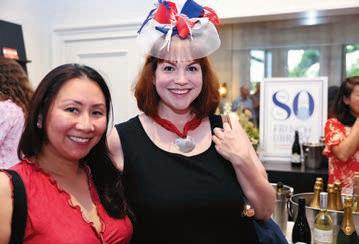
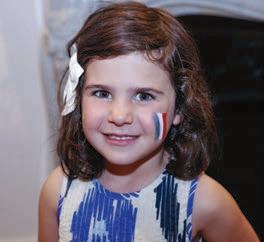



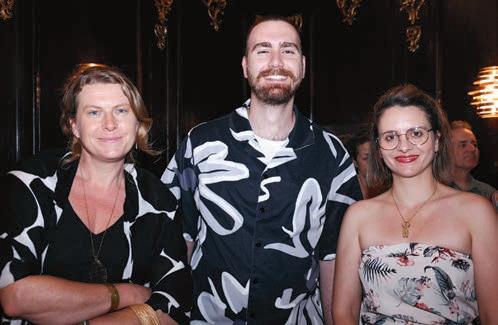
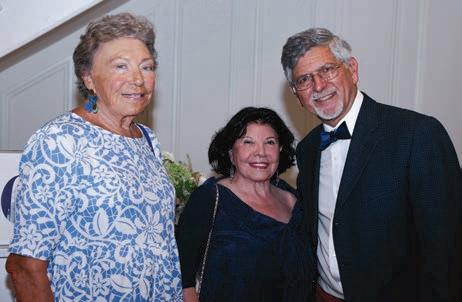
1 Guests arriving for the celebration
2 From left: Barbara Bouquegneau, best-French-dressed contest winner, Madison Maushart, and Sophie Schlenker
3 From left: Frédérique Horn, Marceau Crespo, and Florence Botello from Villa Albertine Boston
4 From left: Brigitte Moufflet, French Library board member Zeina Aoun, and Chairman Steven Galante
5 Guests getting into the Francophile spirit
6. Sybi, a young friend of the French Library
7 Guests enjoying the celebration
8 Chanteuse Musette Suzette sings French songs. Photographs by Claire Vail



We’re Boston’s only dedicated kitchen store for premium cookware and kitchen tools, New England’s largest fine cutlery retailer, a party supply destination as well as home goods and gifts. Since 1982 we have strived to be a trusted destination for locals and visitors alike, located in the heart of Boston, providing inspiration and the tools to create memorable experiences.
Discover for yourself the difference a dedicated staff and a local store makes. Visit Blackstone’s - your home for all your entertaining needs.
40 Charles Street Boston, MA 617-227-4646
blackstonesboston.com

or
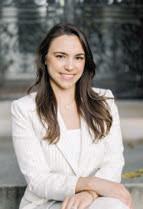

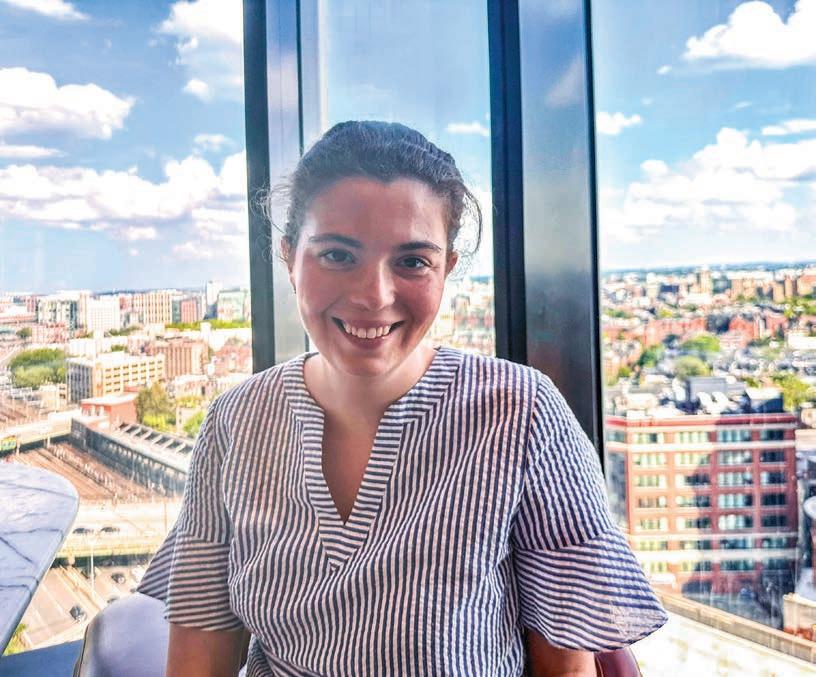
A lover of architecture, history, and fine food shares her typical Sunday
BY LYDIA COSTELLO
MY SUNDAYS START with a delicious latte at home with my partner, Katie, and cat, Winifred (Winnie). Sundays, to me, are restful—a chance to reset and reflect on the week ahead. I’m an avid cook and collector of cookbooks. I spend most Sunday mornings poring over my collection, picking two to three recipes to create throughout the week. My collection is filled with cookbooks passed down from my grandmother and mom, as well as favorites from chefs, restaurants, and the classic Junior League cookbooks. They all hold memories of people and places I love.
My average workday is spent in
front of a computer, so it’s important for me to enjoy the outdoor spaces that Beacon Hill and Back Bay have to offer. The Esplanade is where I go to enjoy some time outside, looping through the Public Garden and walking home down Charles Street. I always give a wave to Upstairs Downstairs, where I spend my Saturdays decorating and selling vintage and new home décor.
I often find myself in at least one grocery store or specialty market in Beacon Hill or Back Bay. Bacco’s Fine Foods is one of my favorites. I usually roast a chicken on Sunday nights— there are so many great recipes that I rely on from incredible chefs like Ina

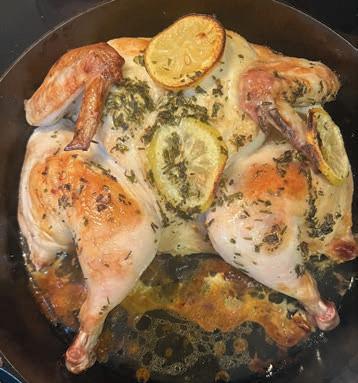
Garten, Erin French, and Julia Child, to name a few. I enjoy testing them, jotting notes in the margins, and turning leftovers into meals throughout the week.
I end most Sundays hanging out with Katie and Winnie, designing and sourcing fabulous items for my clients’ homes, with a reality show playing in the background.
Lydia Costello is a Beacon Hill resident who spends her days designing interiors for clients throughout the Northeast and her evenings cooking and baking. You can follow her design adventures on social media @Passionforpreservation.
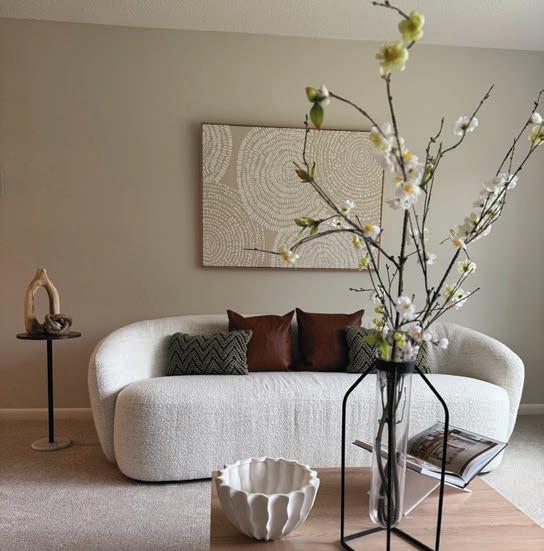



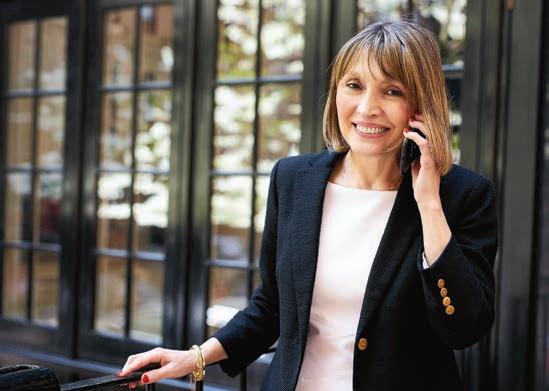
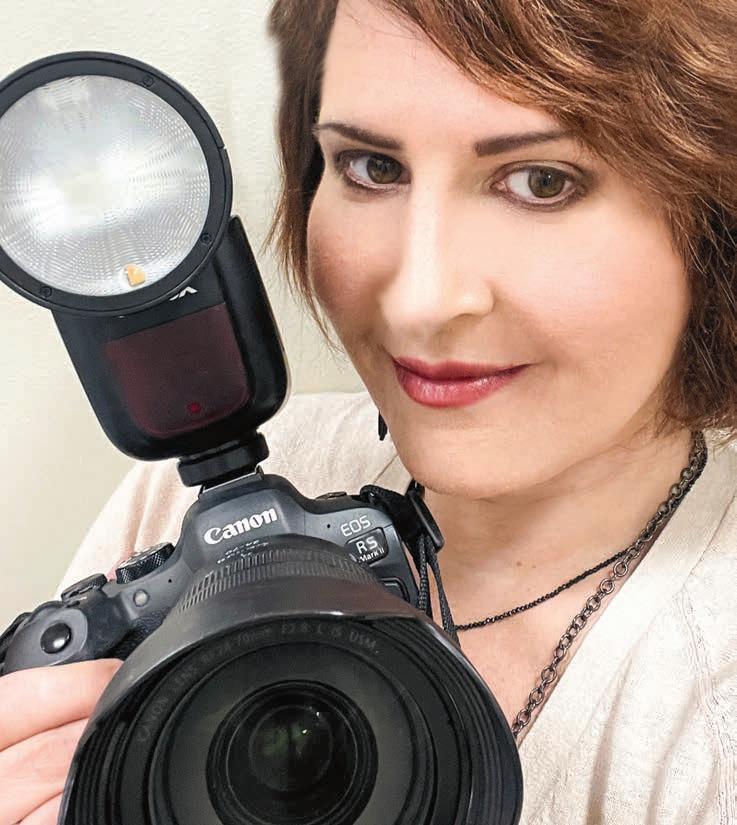
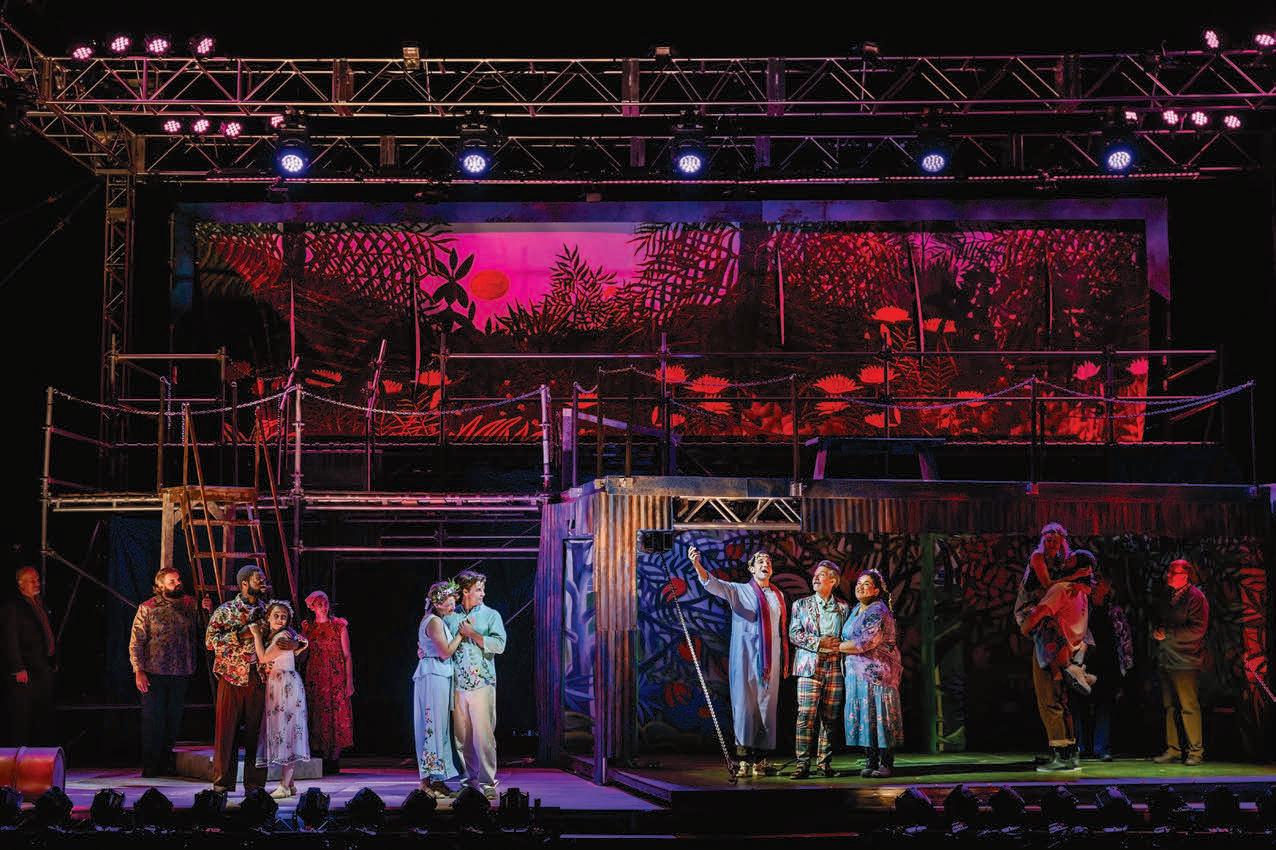
BOSTON COMMON became the Forest of Arden from Shakespeare’s lush romantic comedy “As You Like It” in late July and August. Commonwealth Shakespeare Company and Director Steven Maler put on lavish production that had audiences delighting in the Bard’s wit and wisdom.
Have a great image for Photo Op? Submit your high-resolution shot to editor@mybostonmag.com.

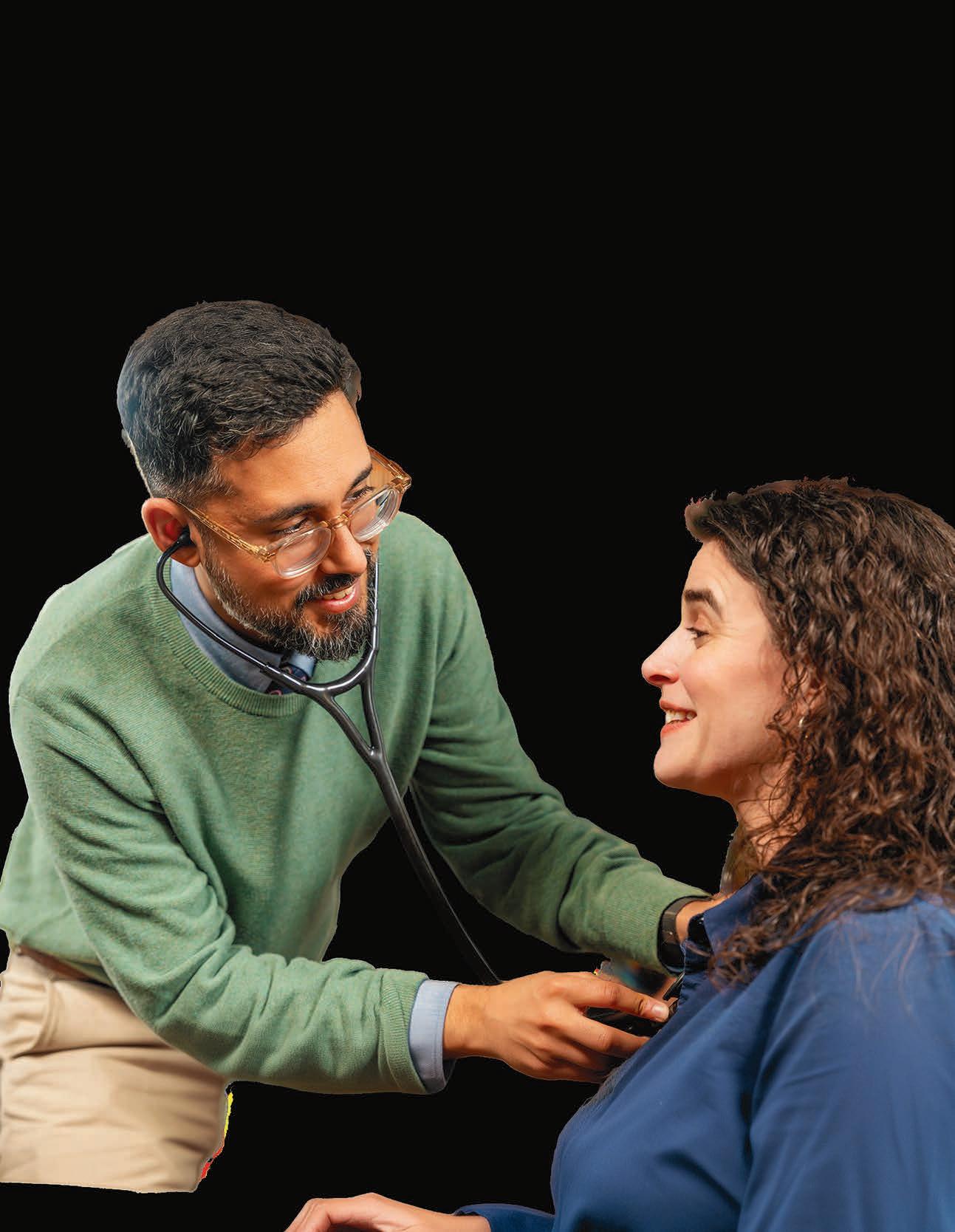
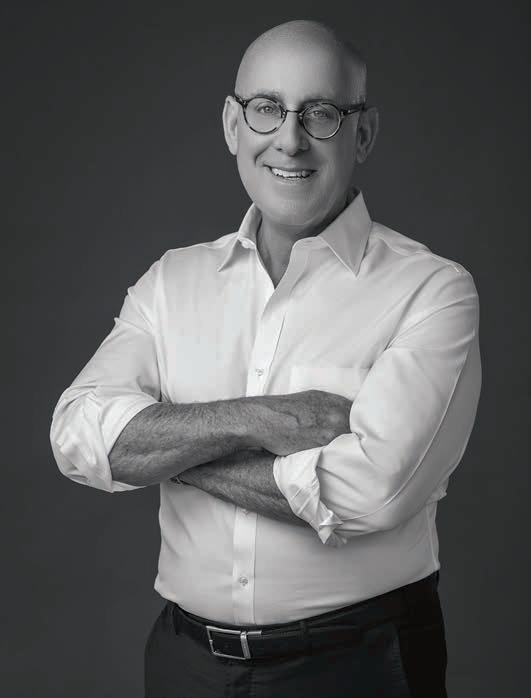

Call (or text!) Peter at (508) 353-9721, or email him at peter@mgsgrouprealestate.com.
Meet Peter Hill.
Meet Peter Hill.
With decades of valuable experience and a savvy knowledge of the area you can only get from growing up here, Peter Hill not only knows how to treat his clients like they’re the Royal Family, he also knows how to negotiate like the head of the United Nations. And he’s nice. Yup, nice, as in you’ll not only enjoy going on your real estate journey with him, but you’ll also miss him, once it ends. What’s more is that he’s part of the MGS Group Real Estate family, so he’s got 15 stellar agents behind him, plus a list of connections and resources as long as the Charles River, that can assist clients with everything from preparing their home to sell, to doing in their new home. So, if you’re ready to buy or sell, or both, don’t make a move without calling (or texting!) Peter at 508 353-9721.
With decades of valuable experience and a savvy knowledge of the area you can only get from growing up here, Peter Hill not only knows how to treat his clients like they’re the Royal Family, he also knows how to negotiate like the head of the United Nations. And he’s nice. Yup, nice, as in you’ll not only enjoy going on your real estate journey with him, but you’ll also miss him, once it ends. What’s more is that he’s part of the MGS Group Real Estate family, so he’s got 15 stellar agents behind him, plus a list of connections and resources as long as the Charles River, that can assist clients with everything from preparing their home to sell, to doing in their new home. So, if you’re ready to buy or sell, or both, don’t make a move without calling (or texting!) Peter at 508 353-9721.